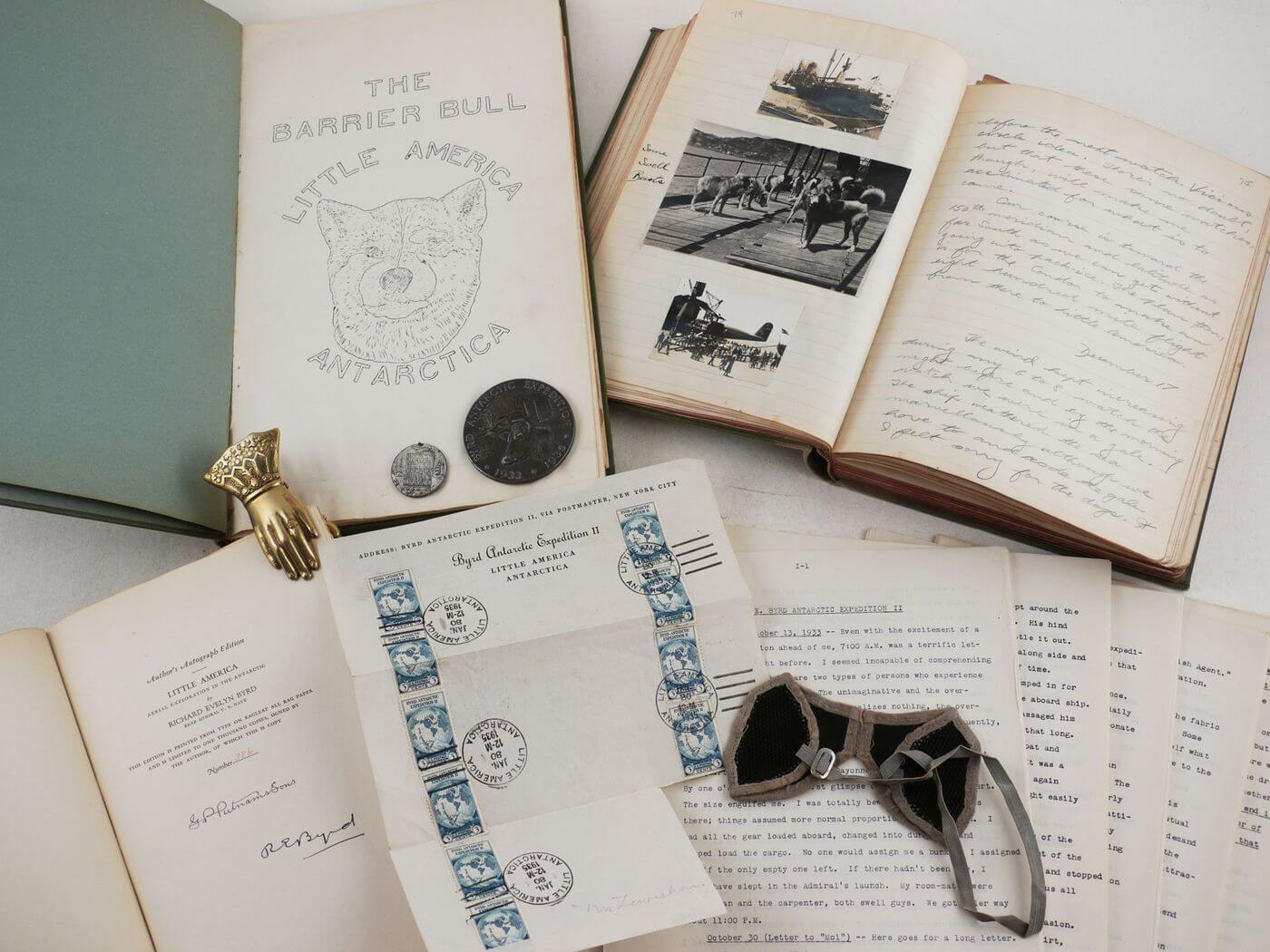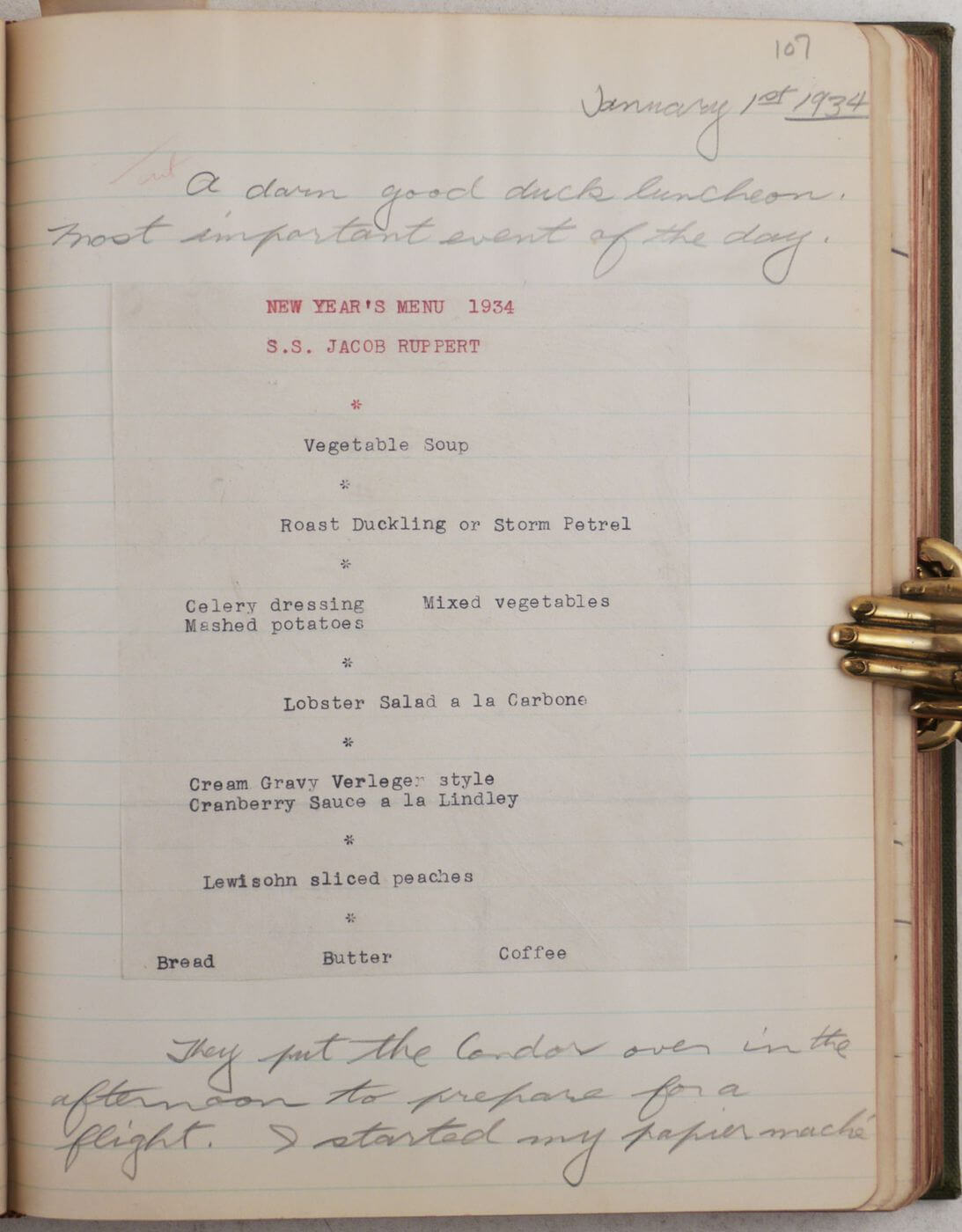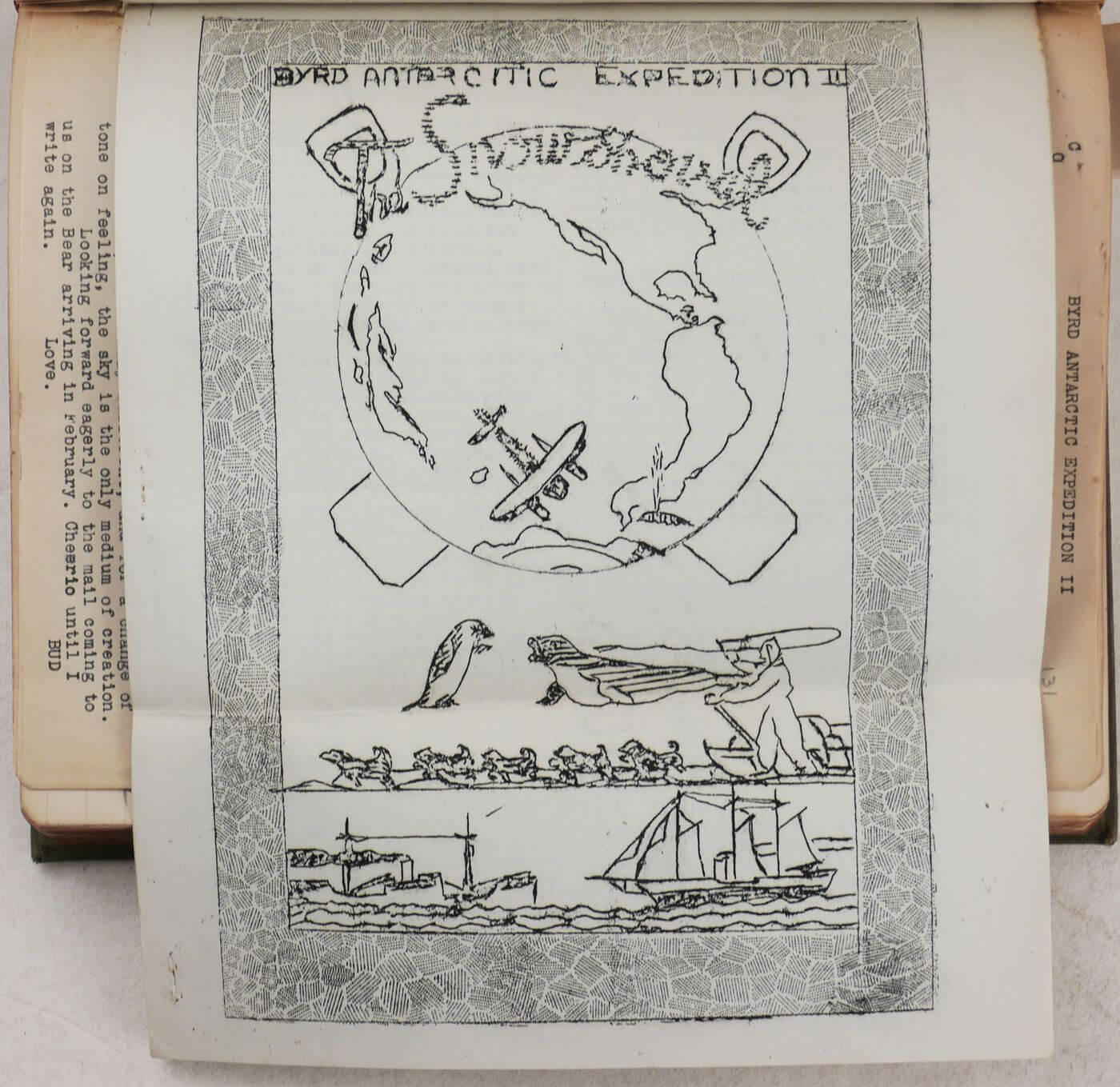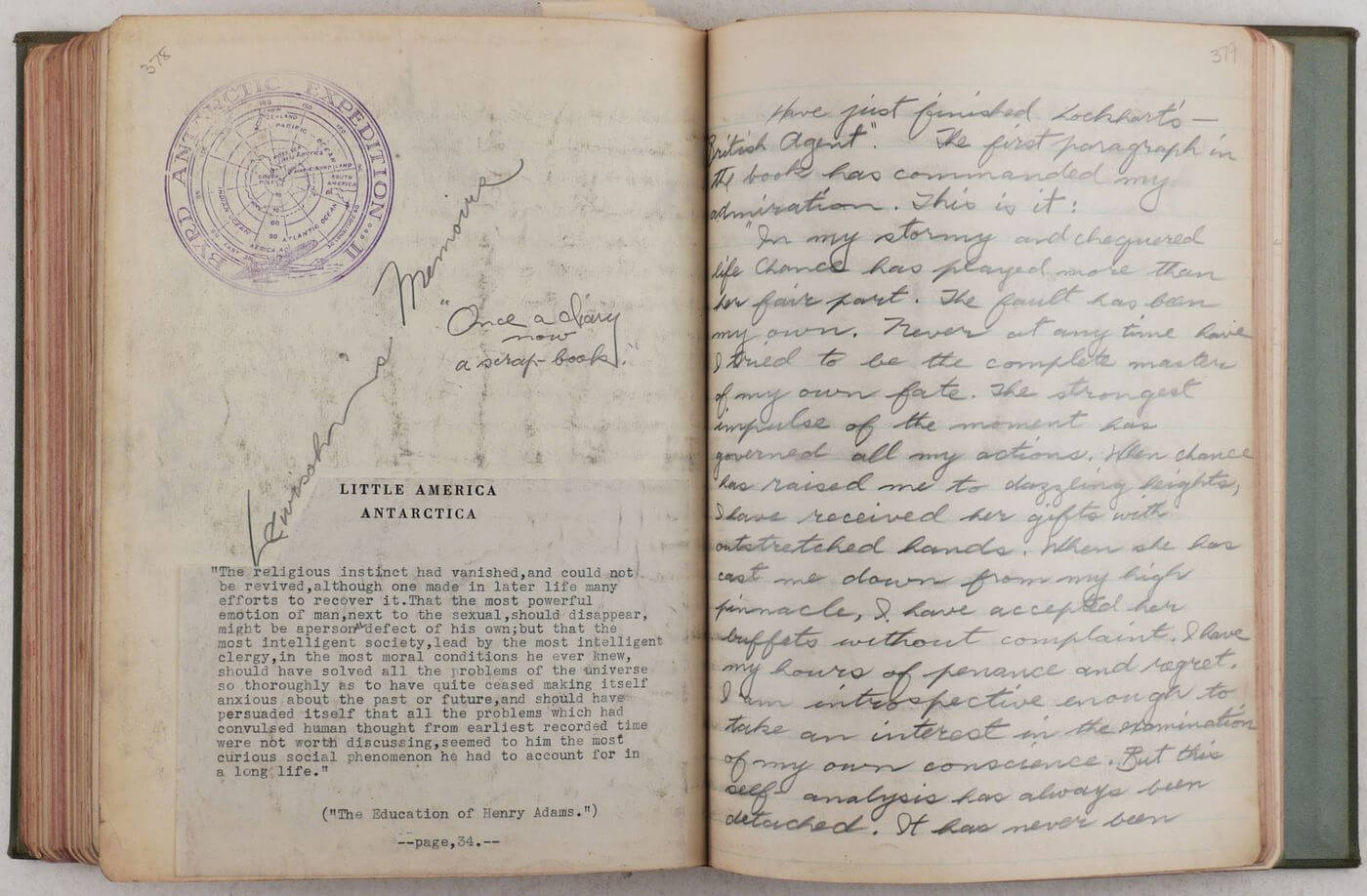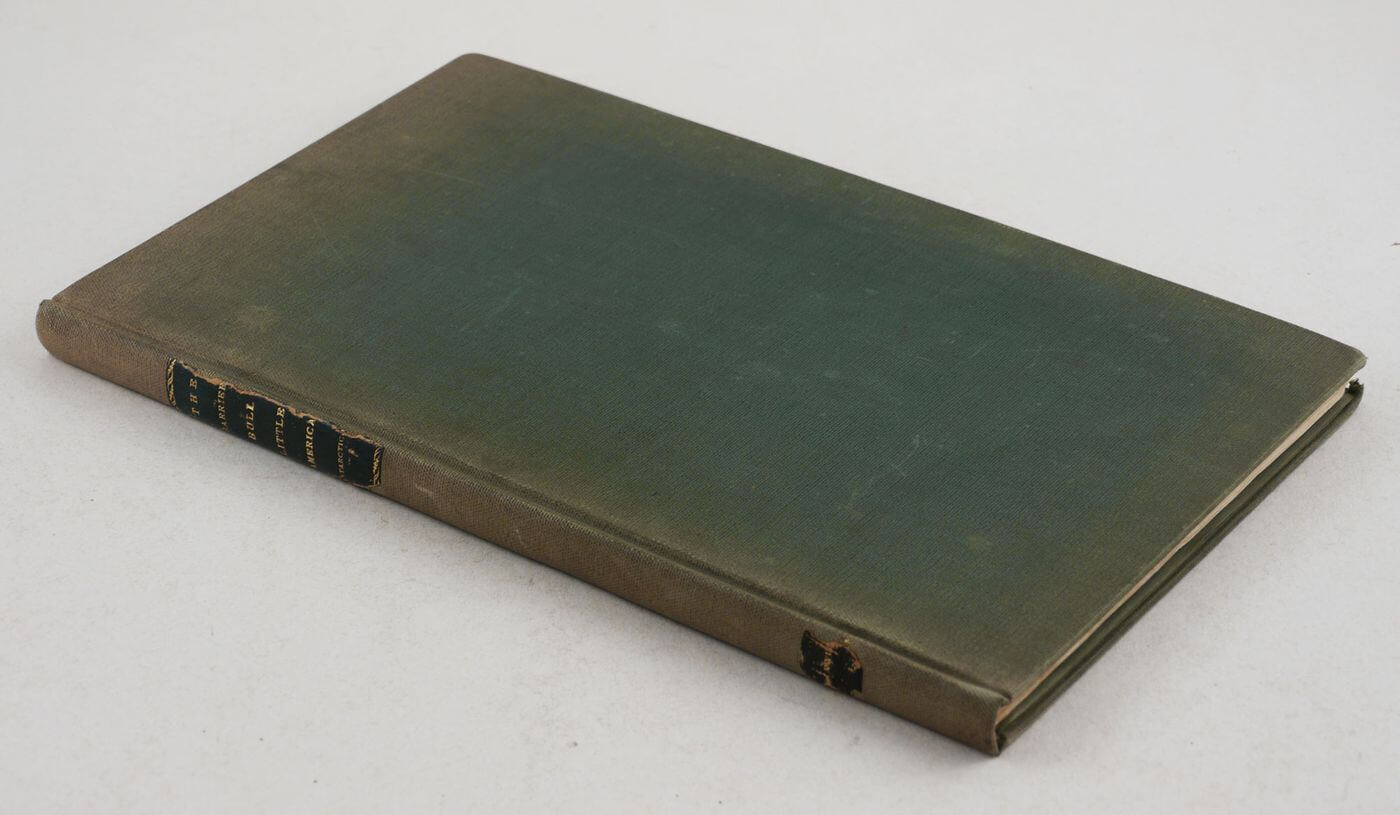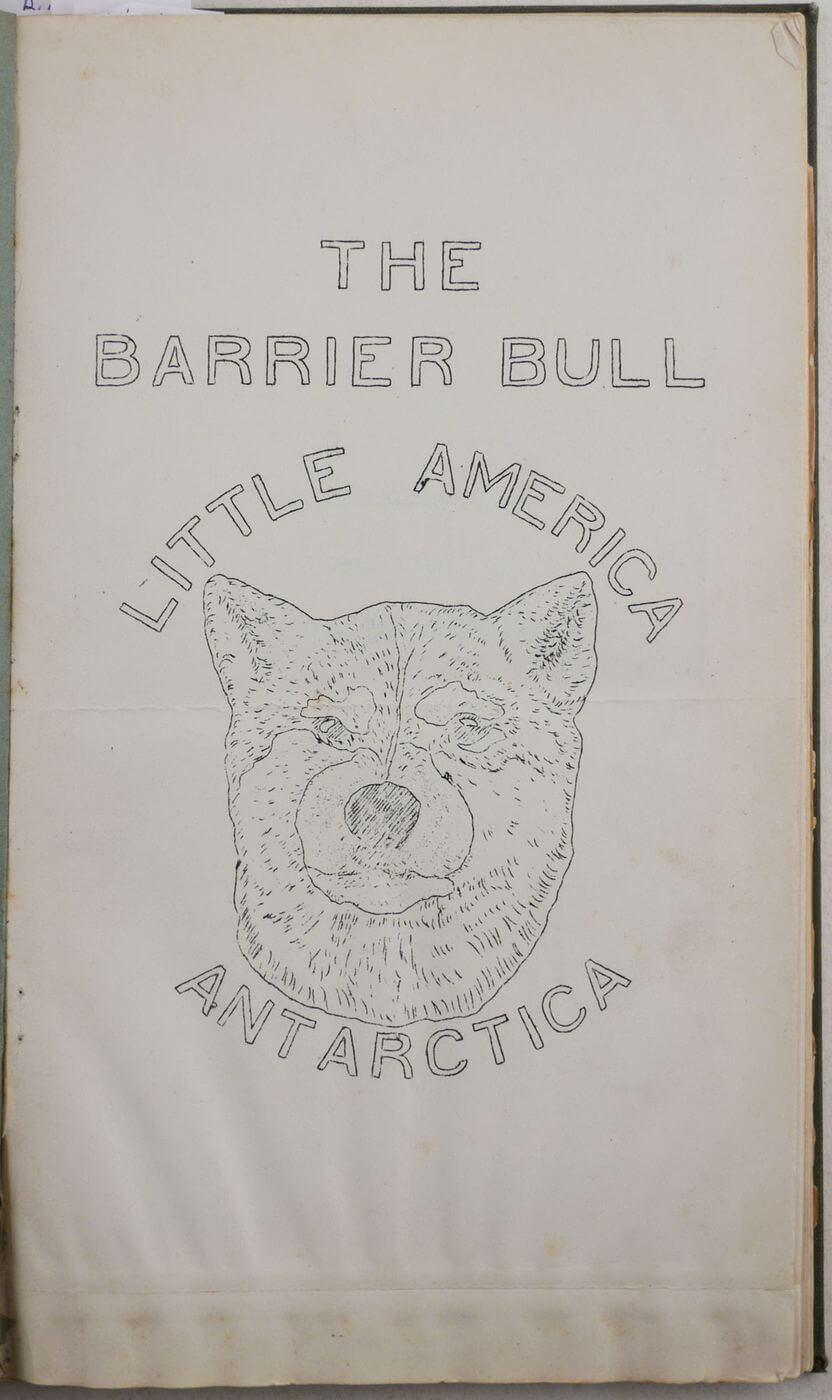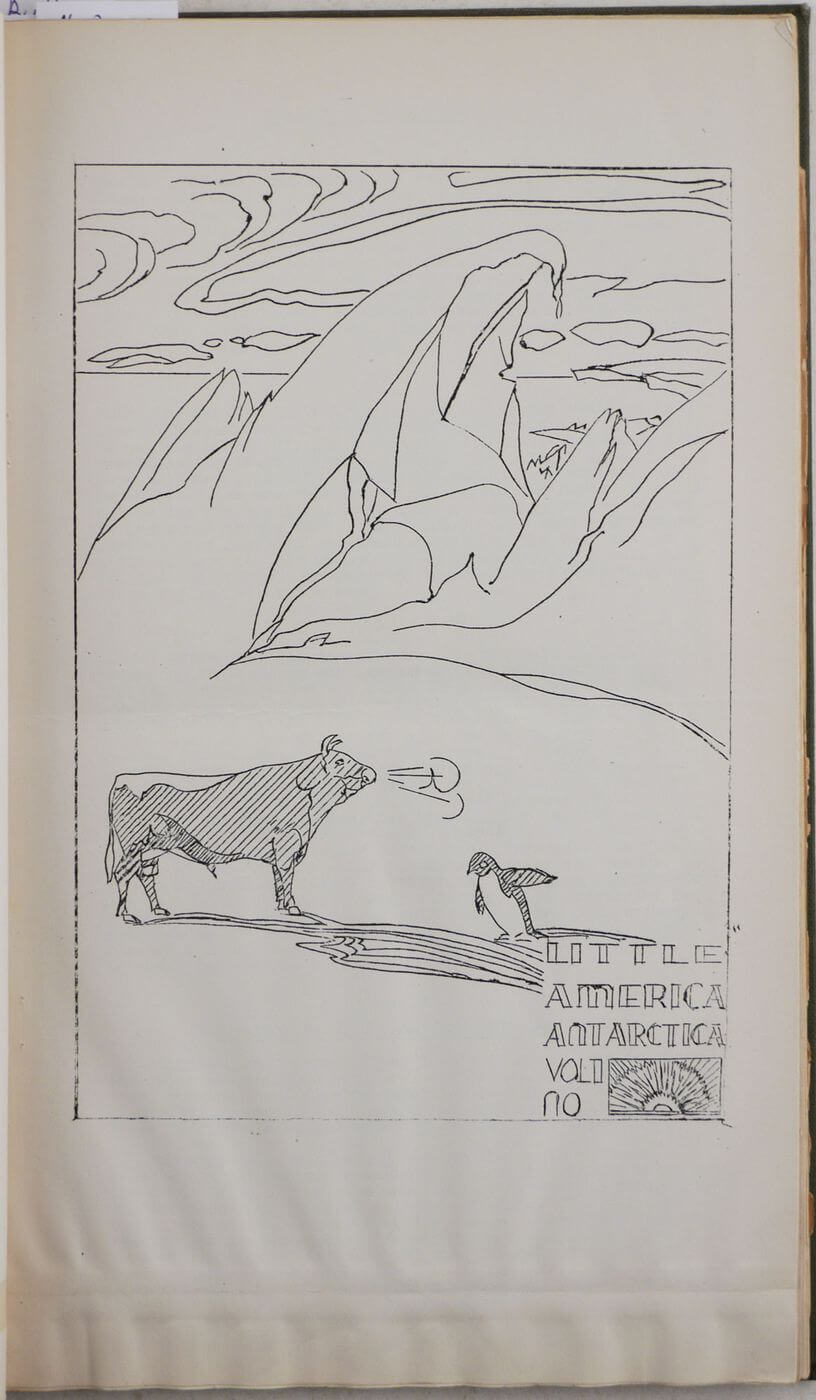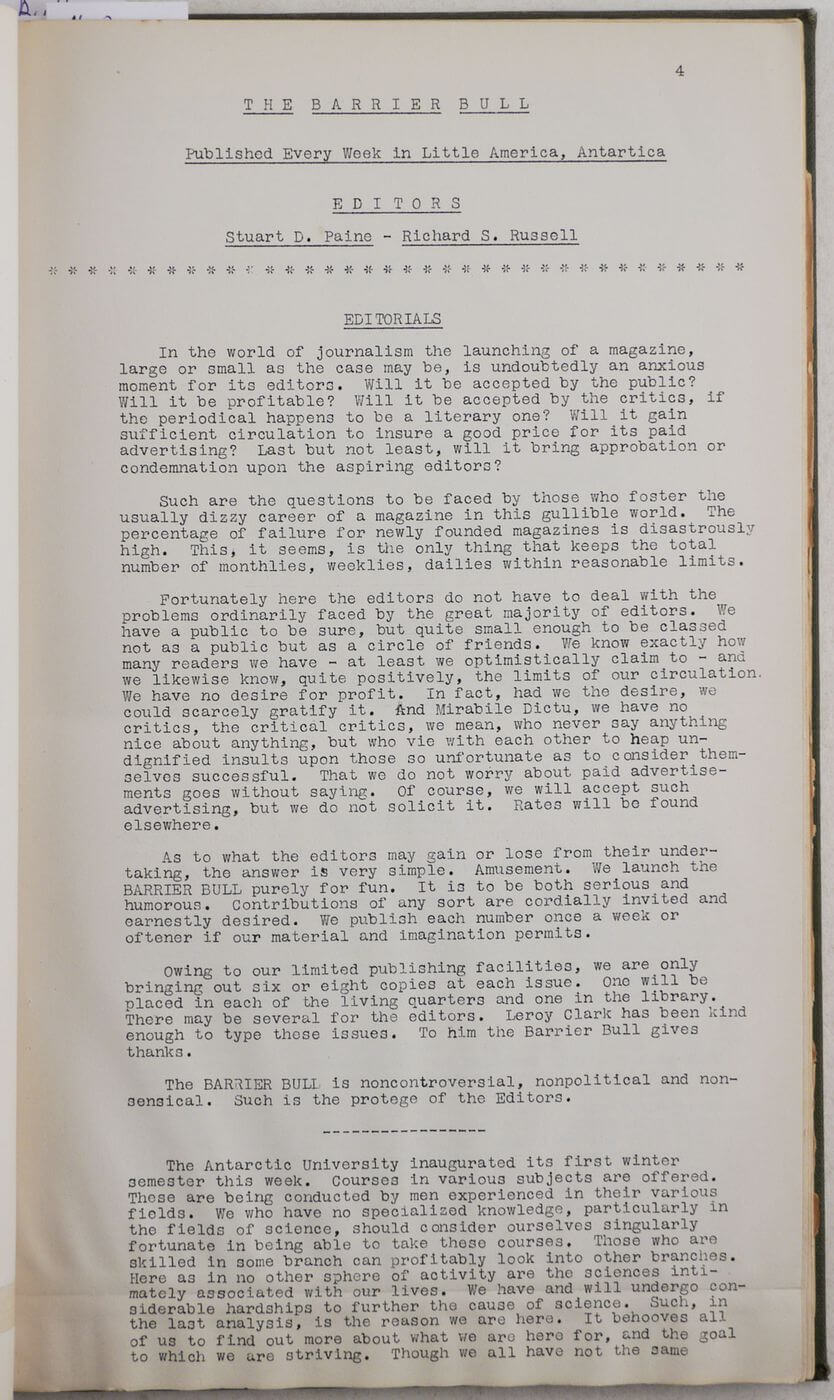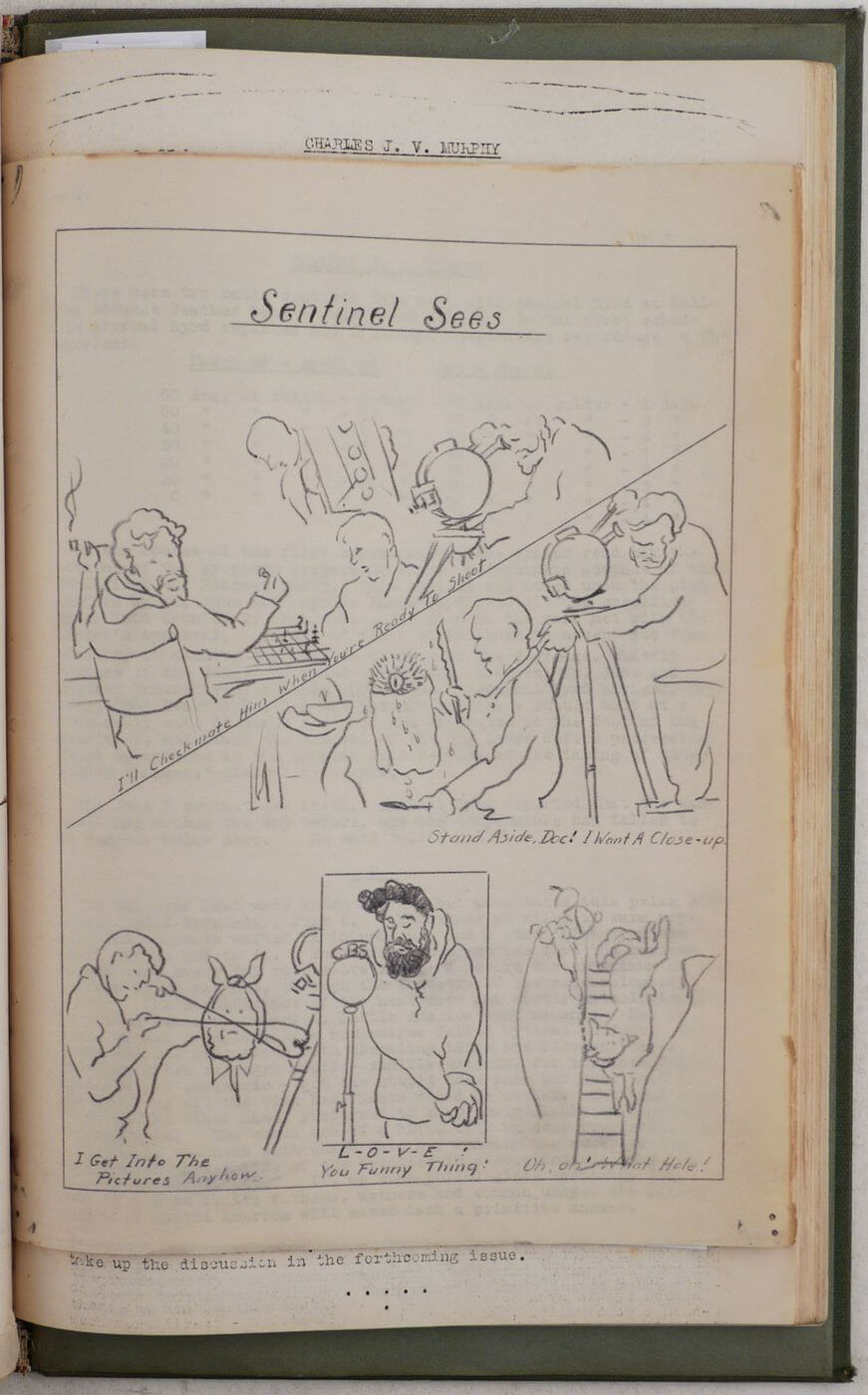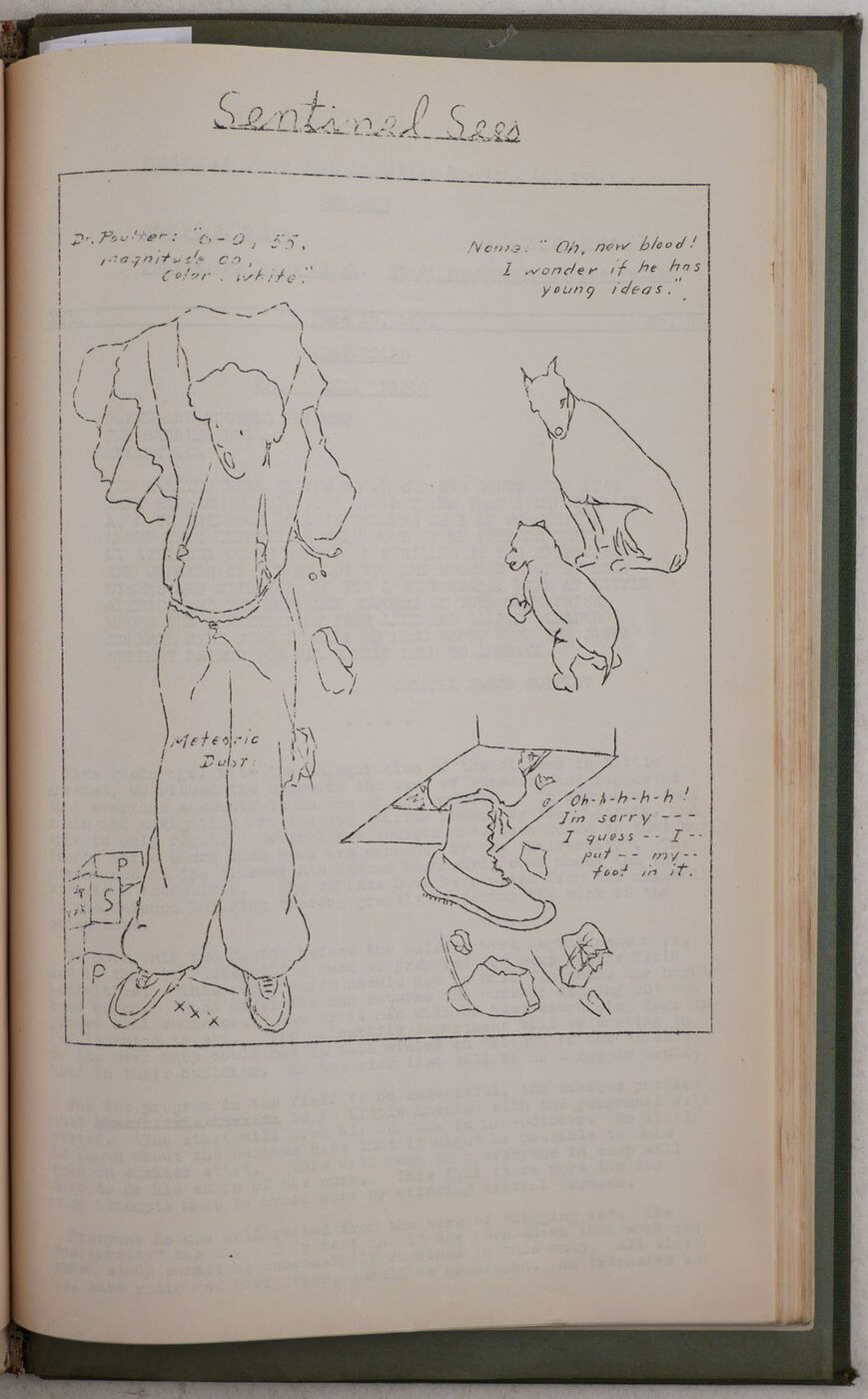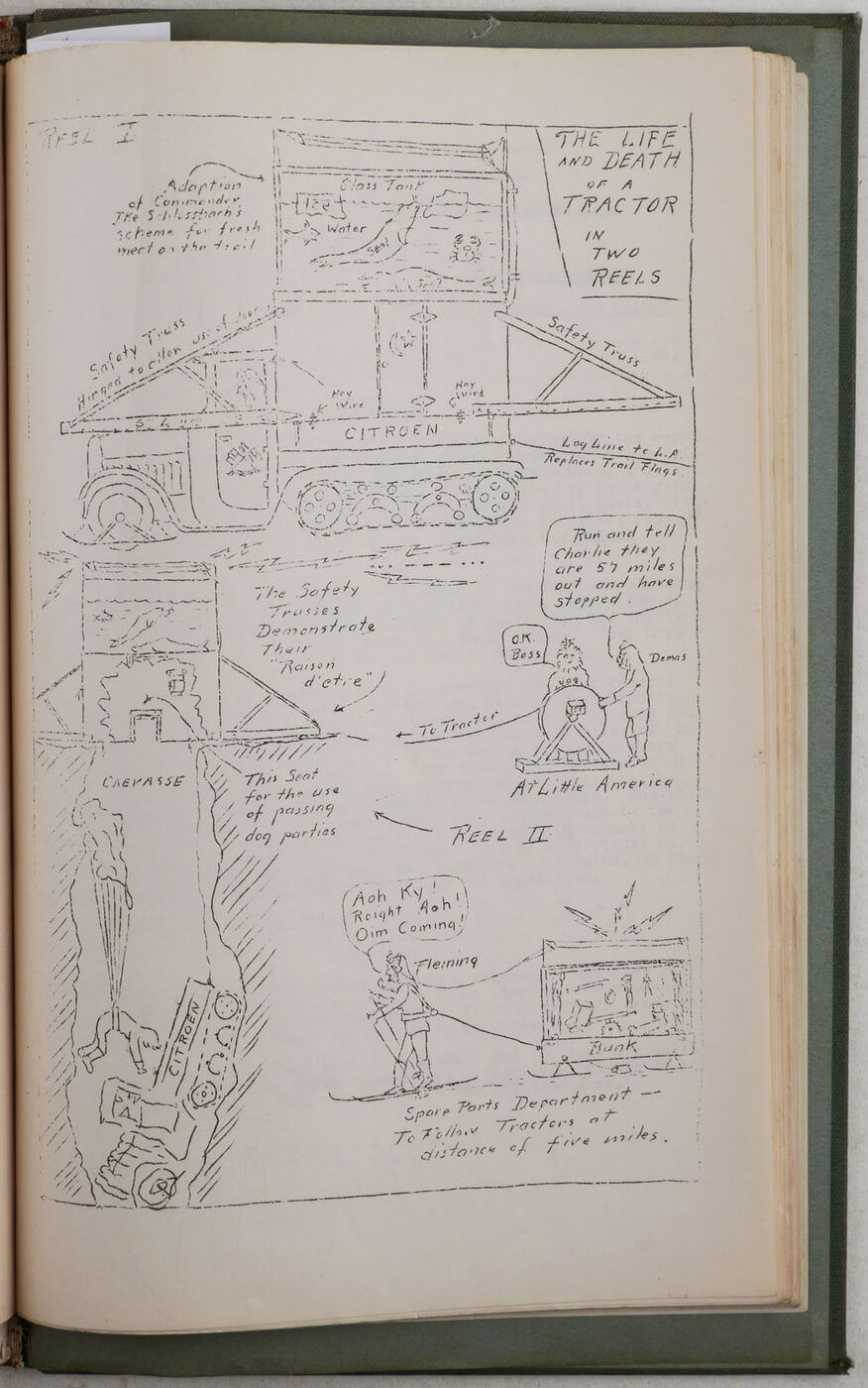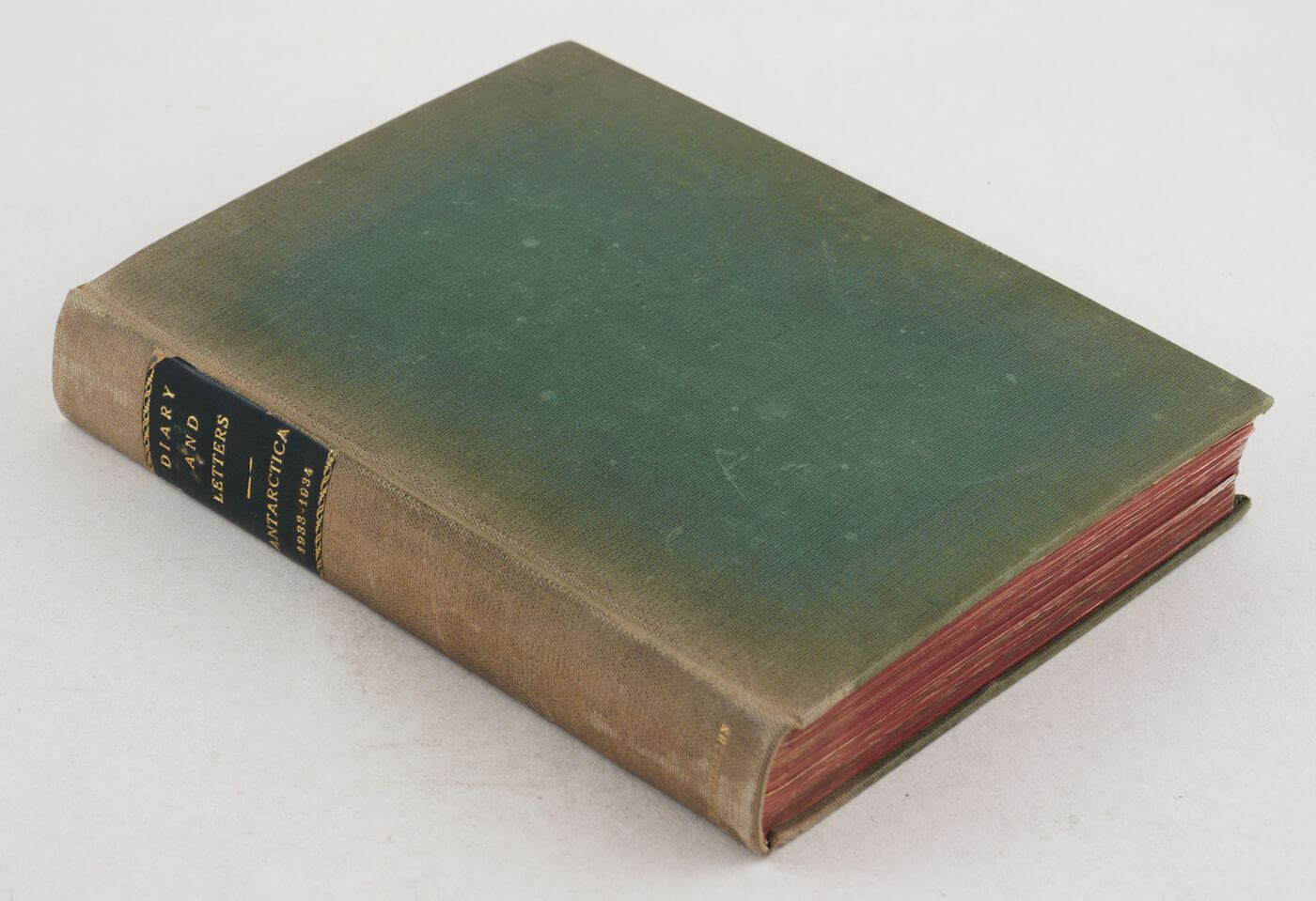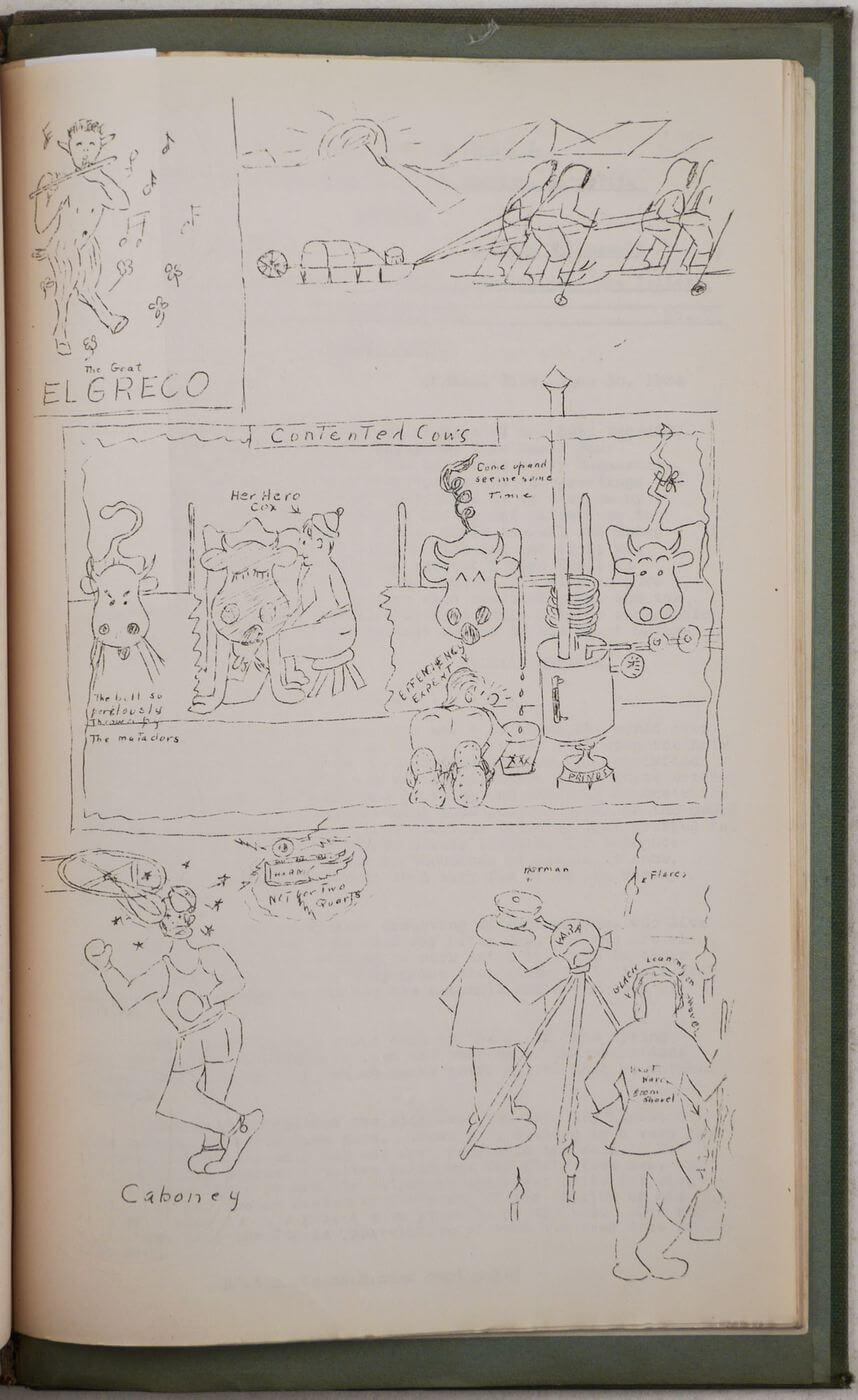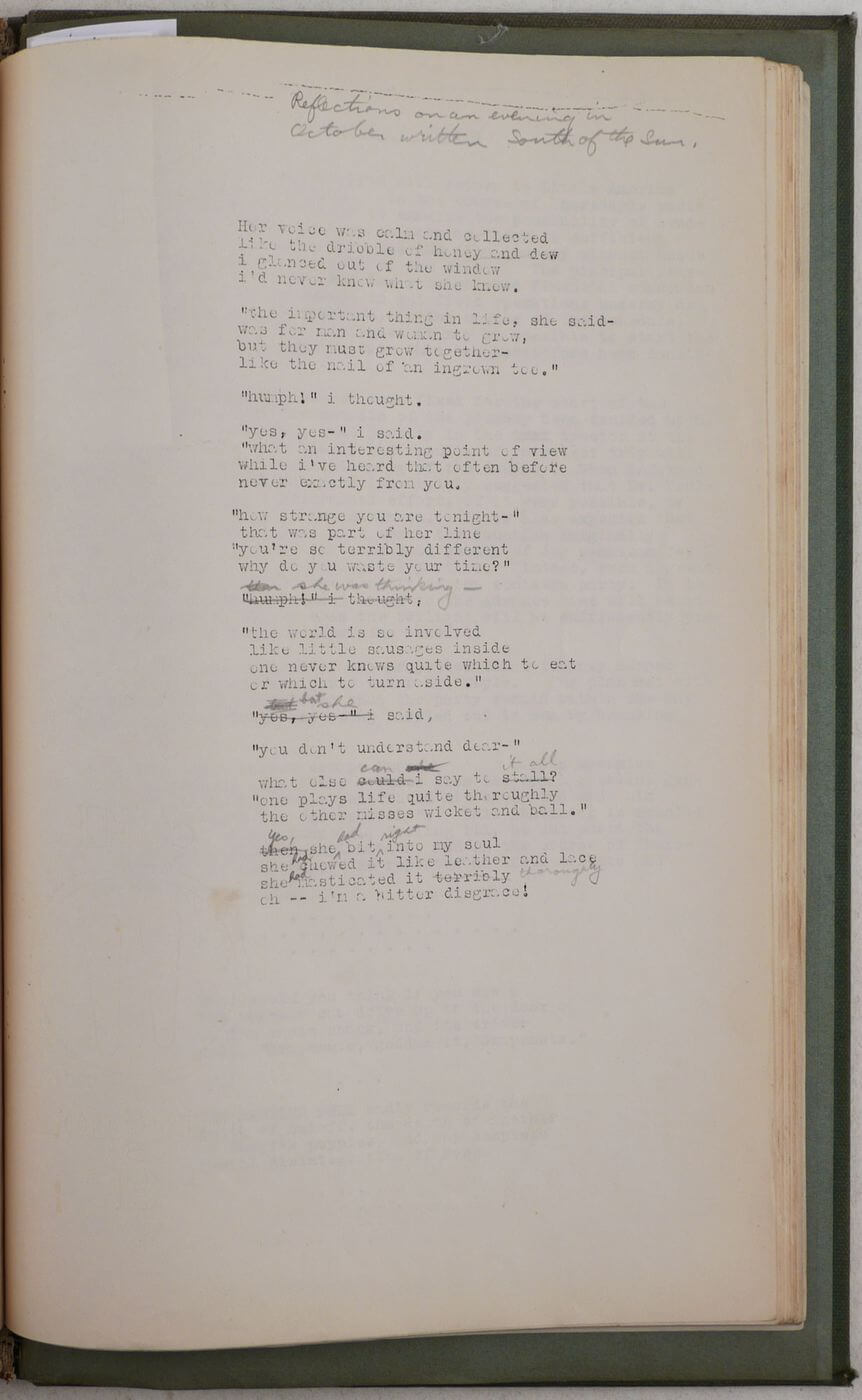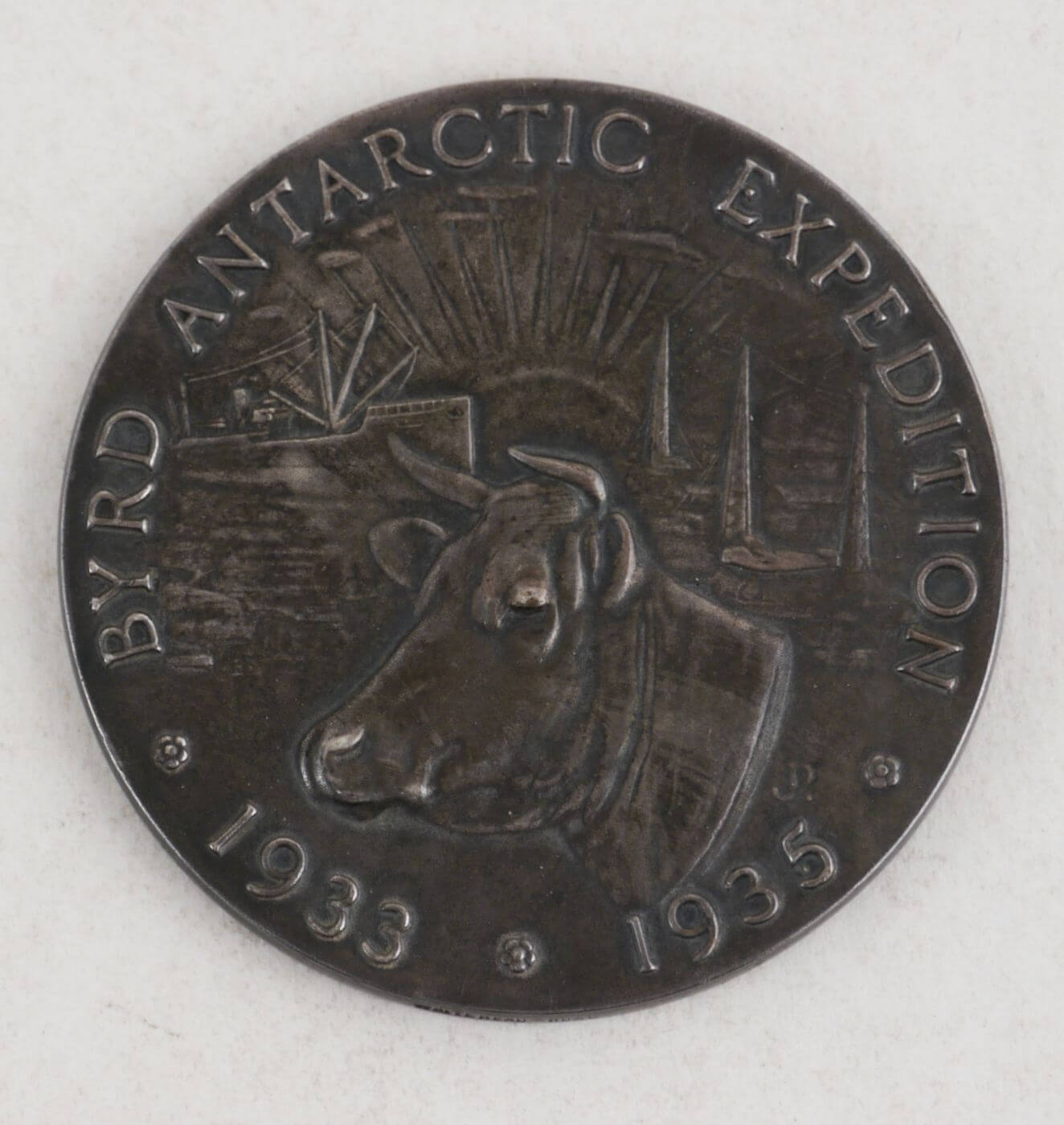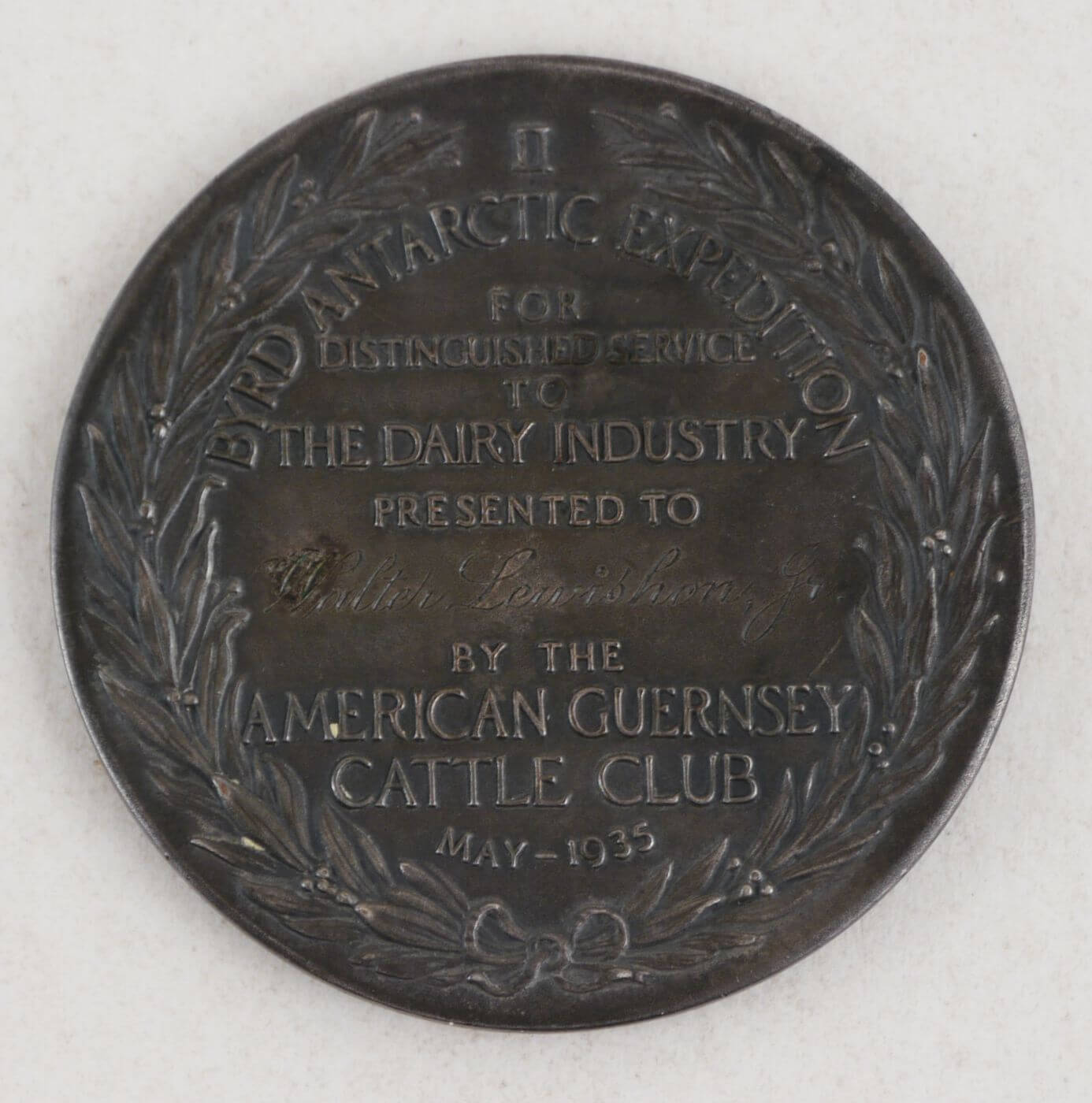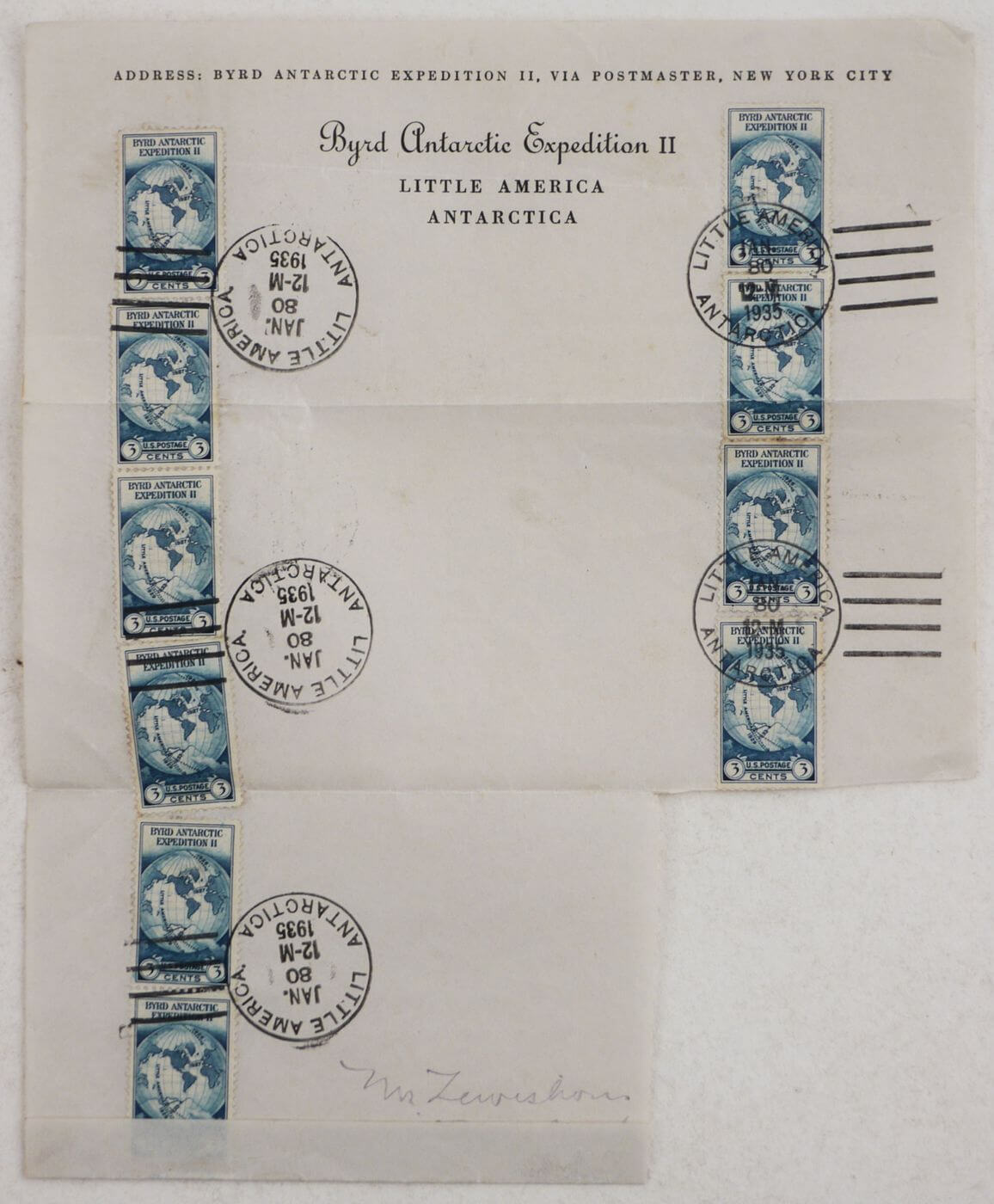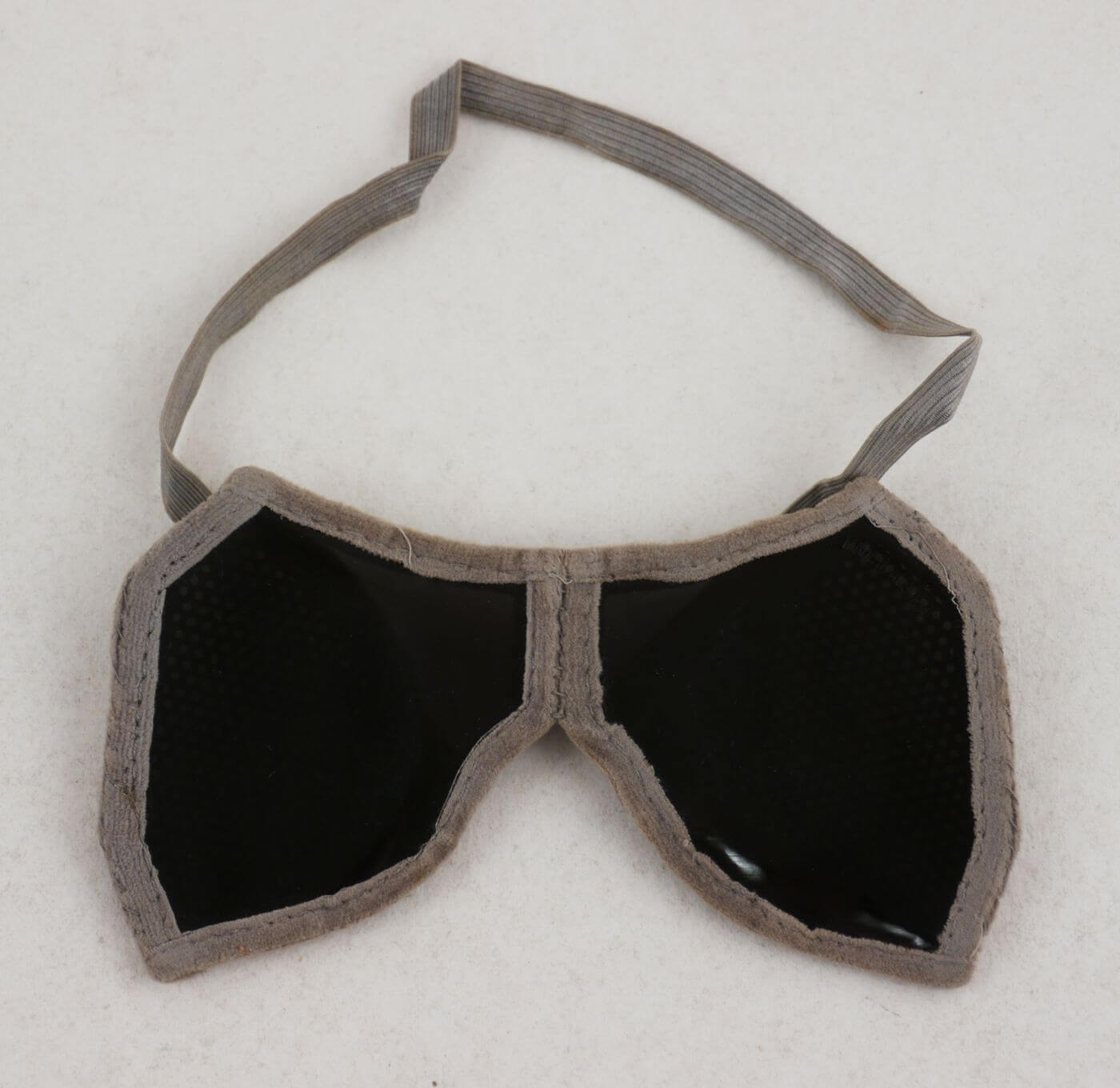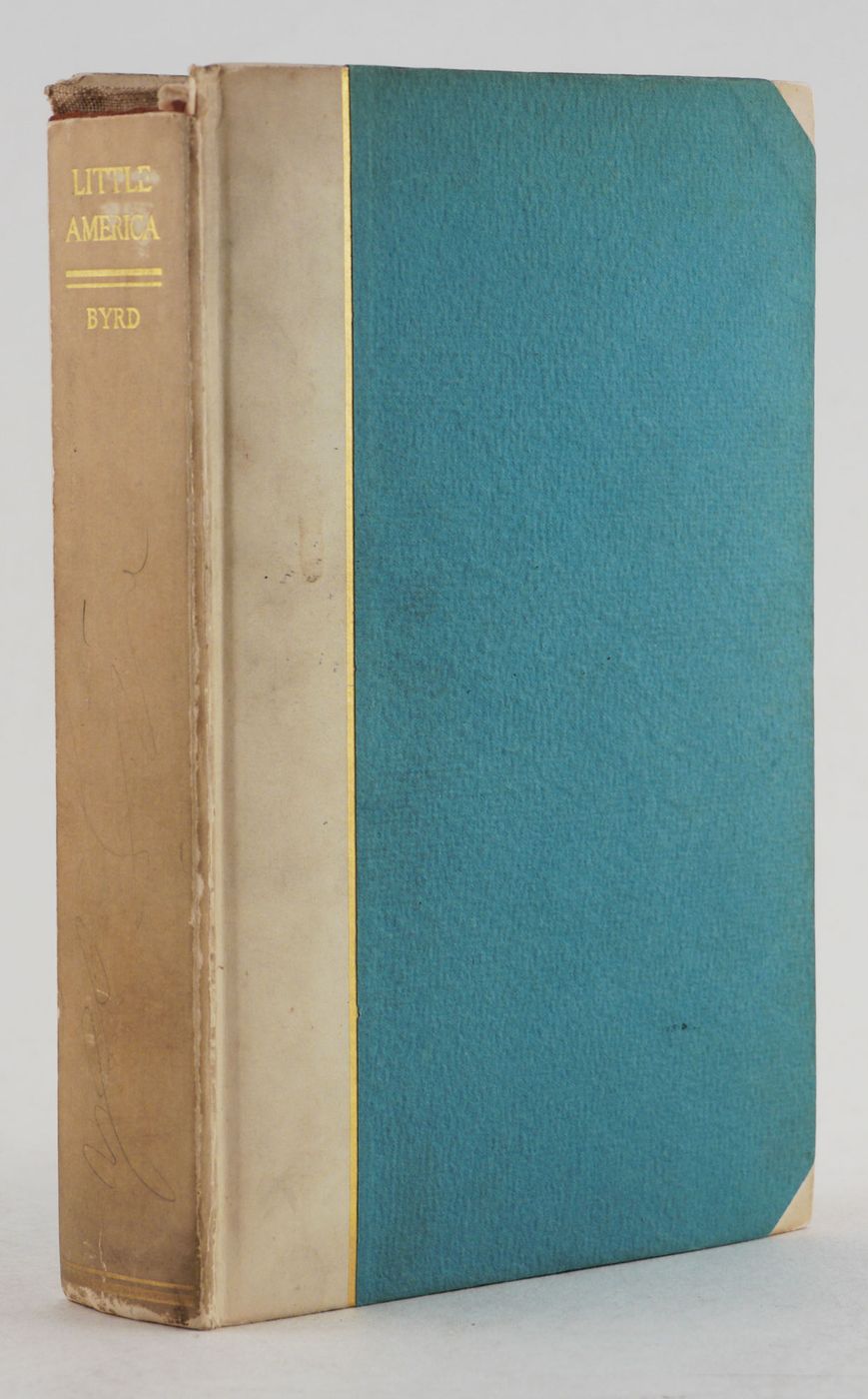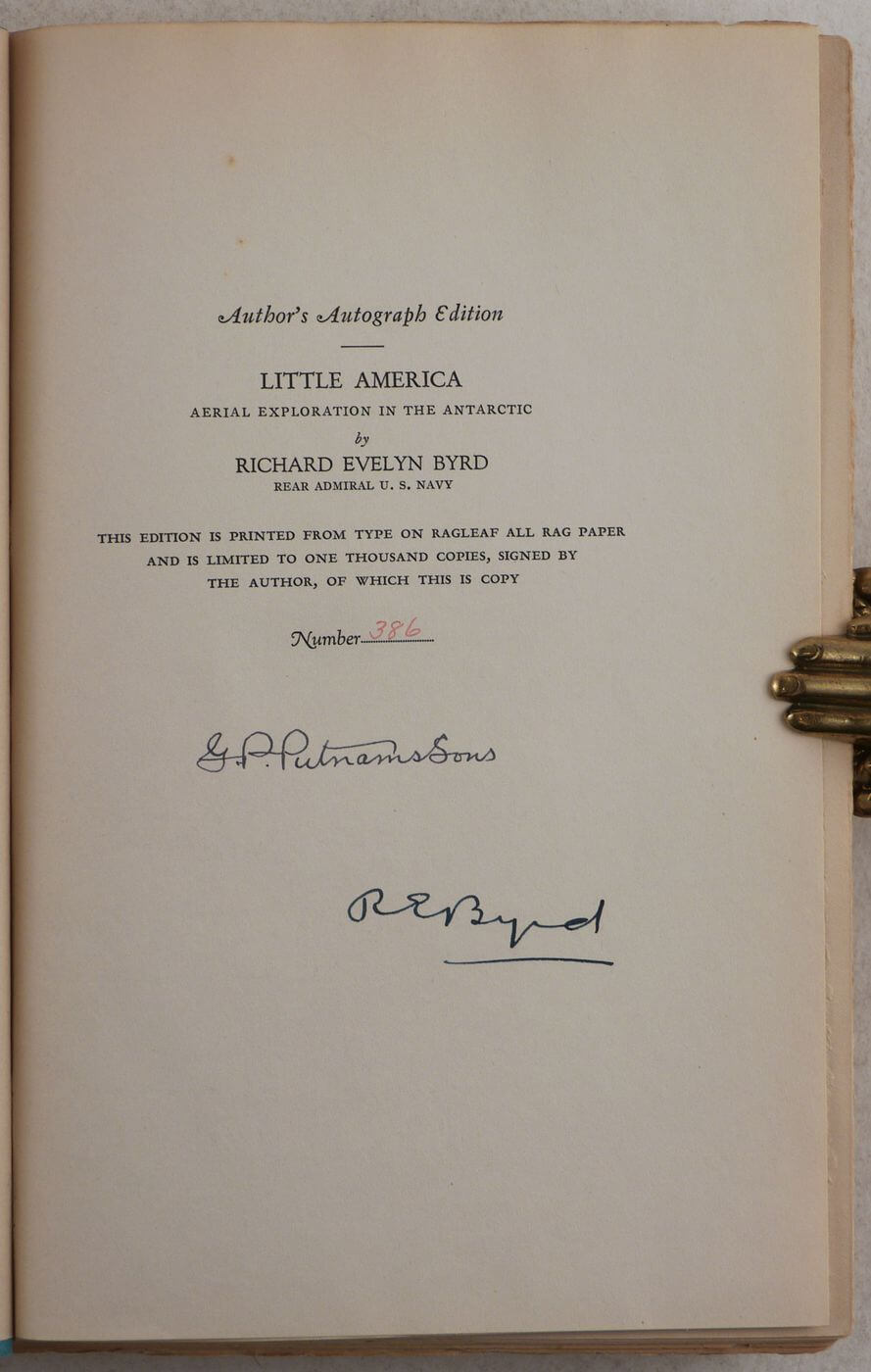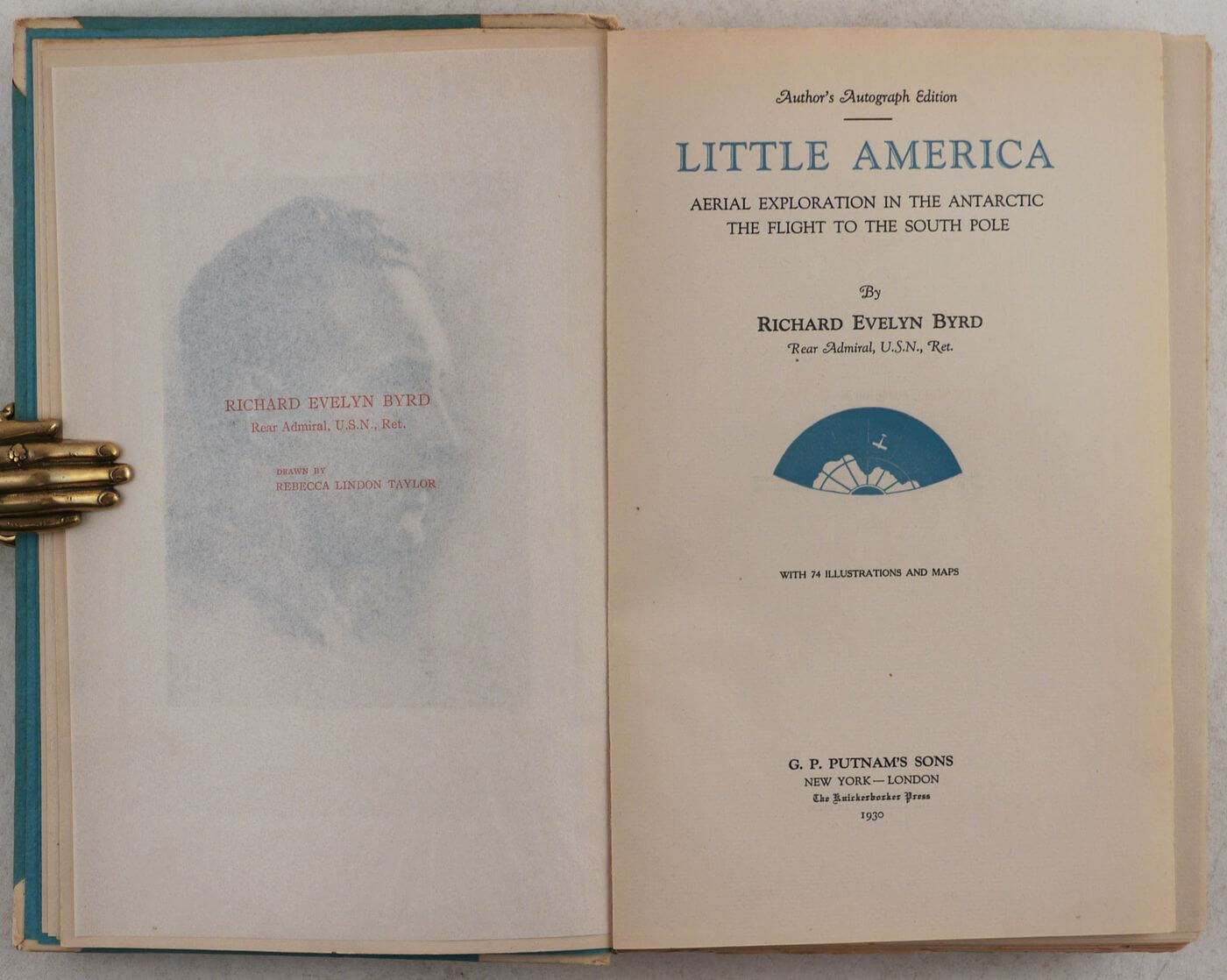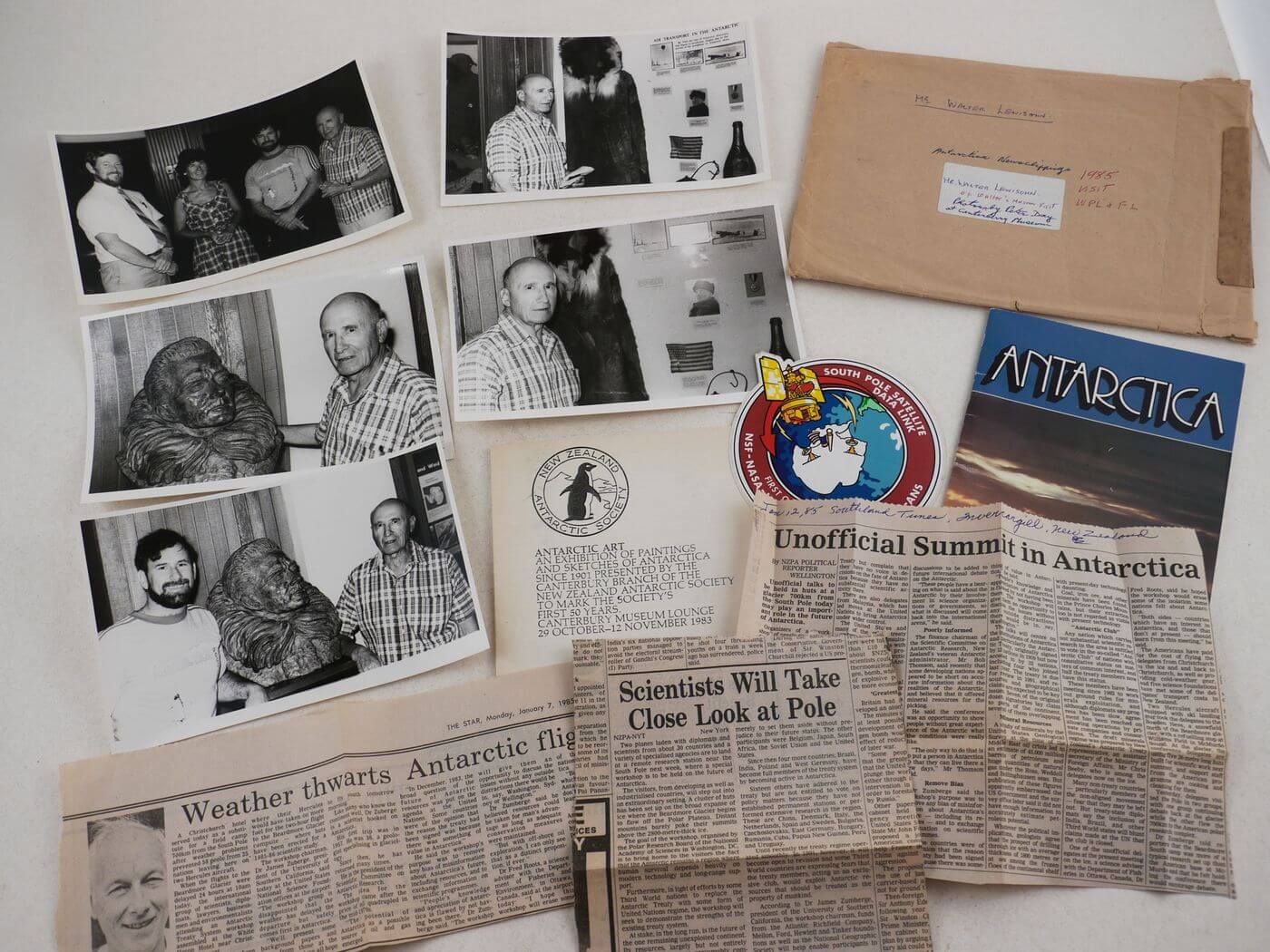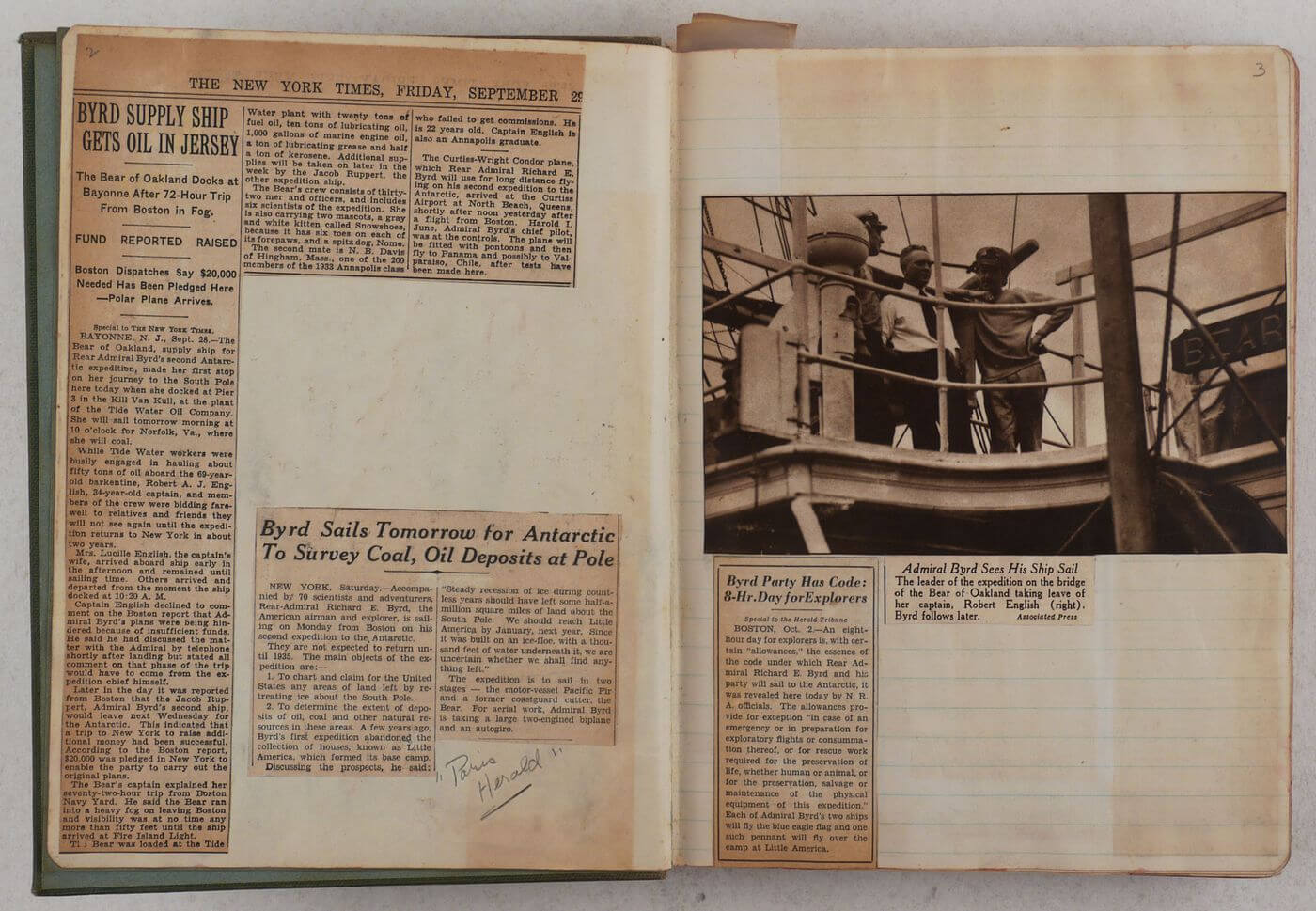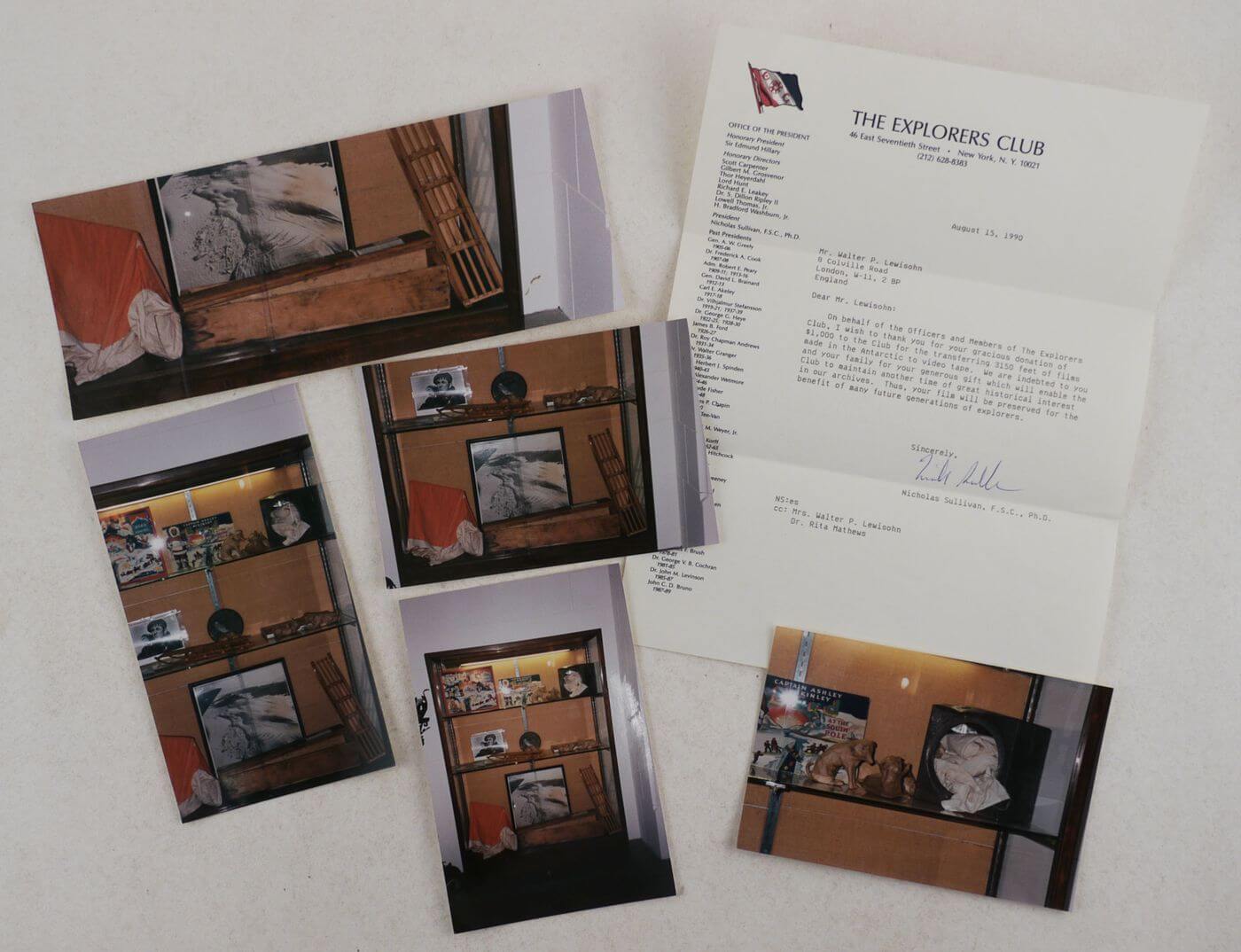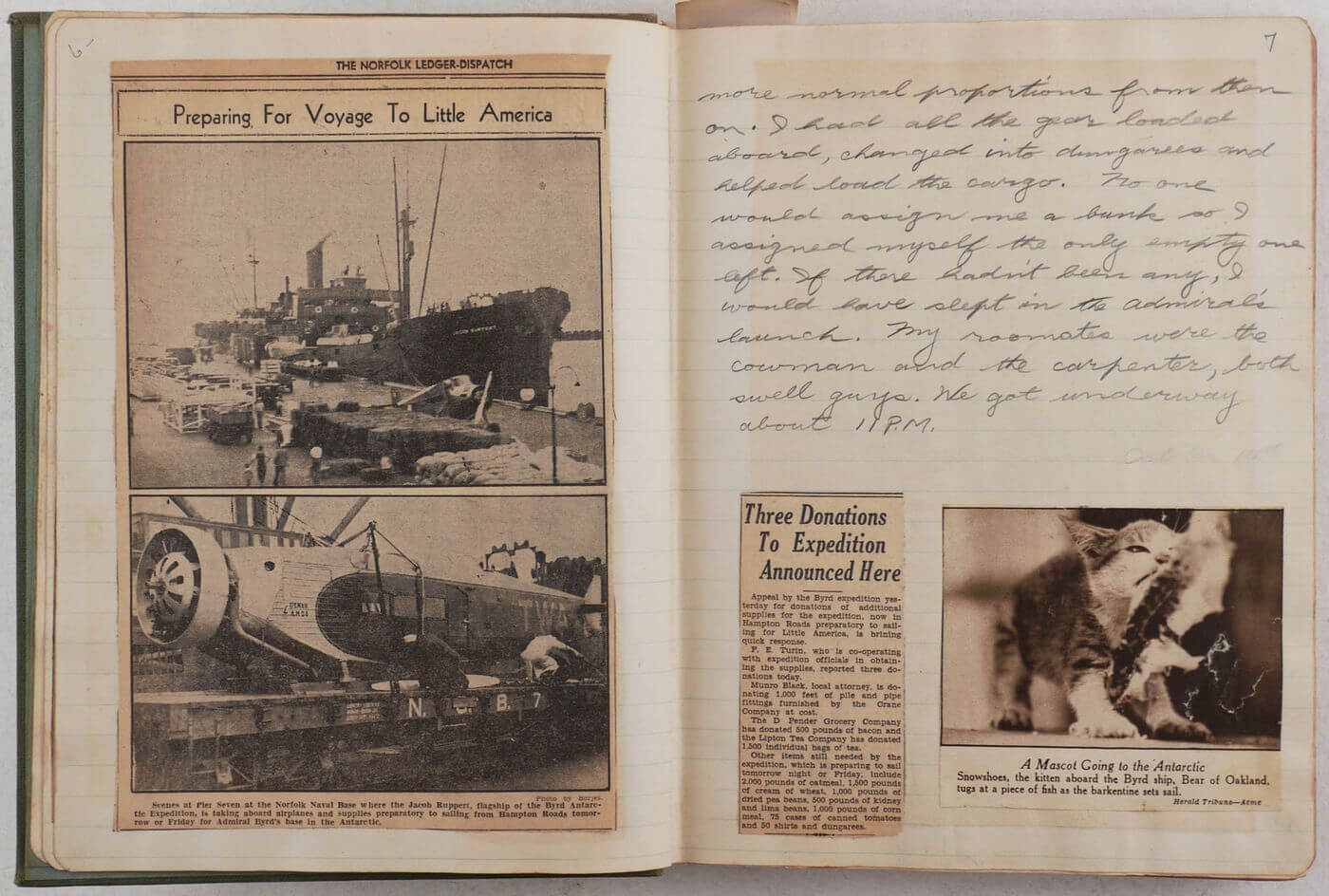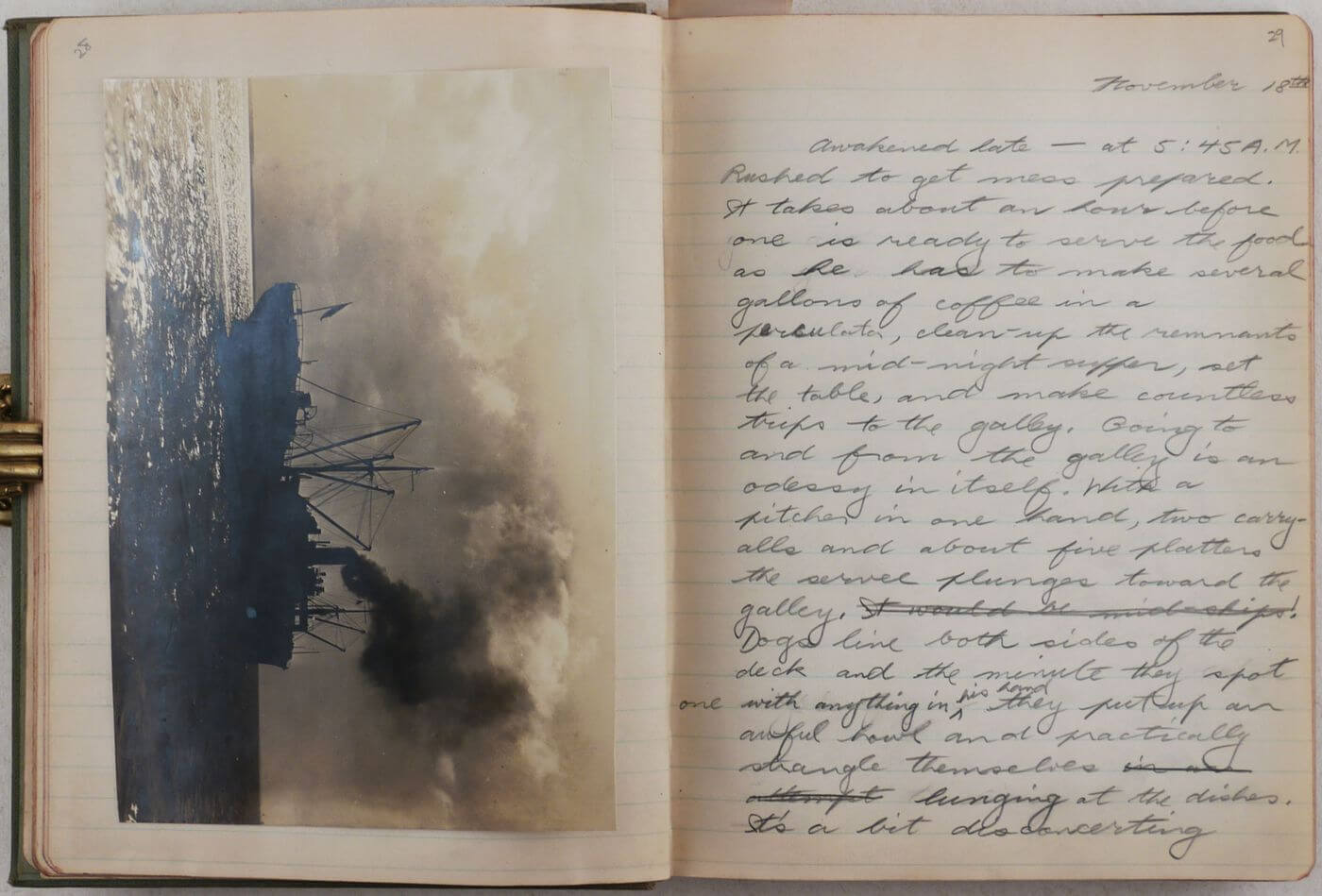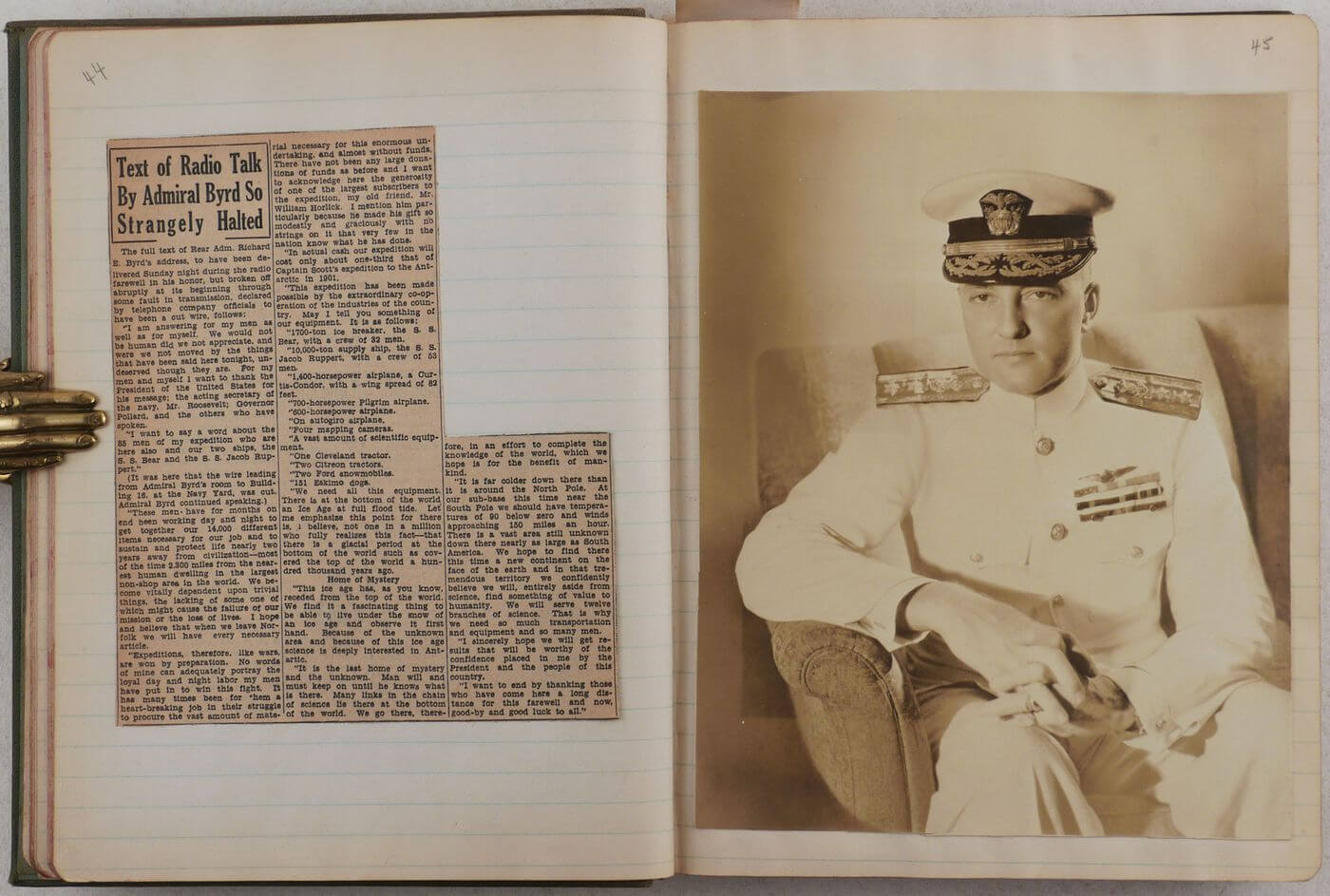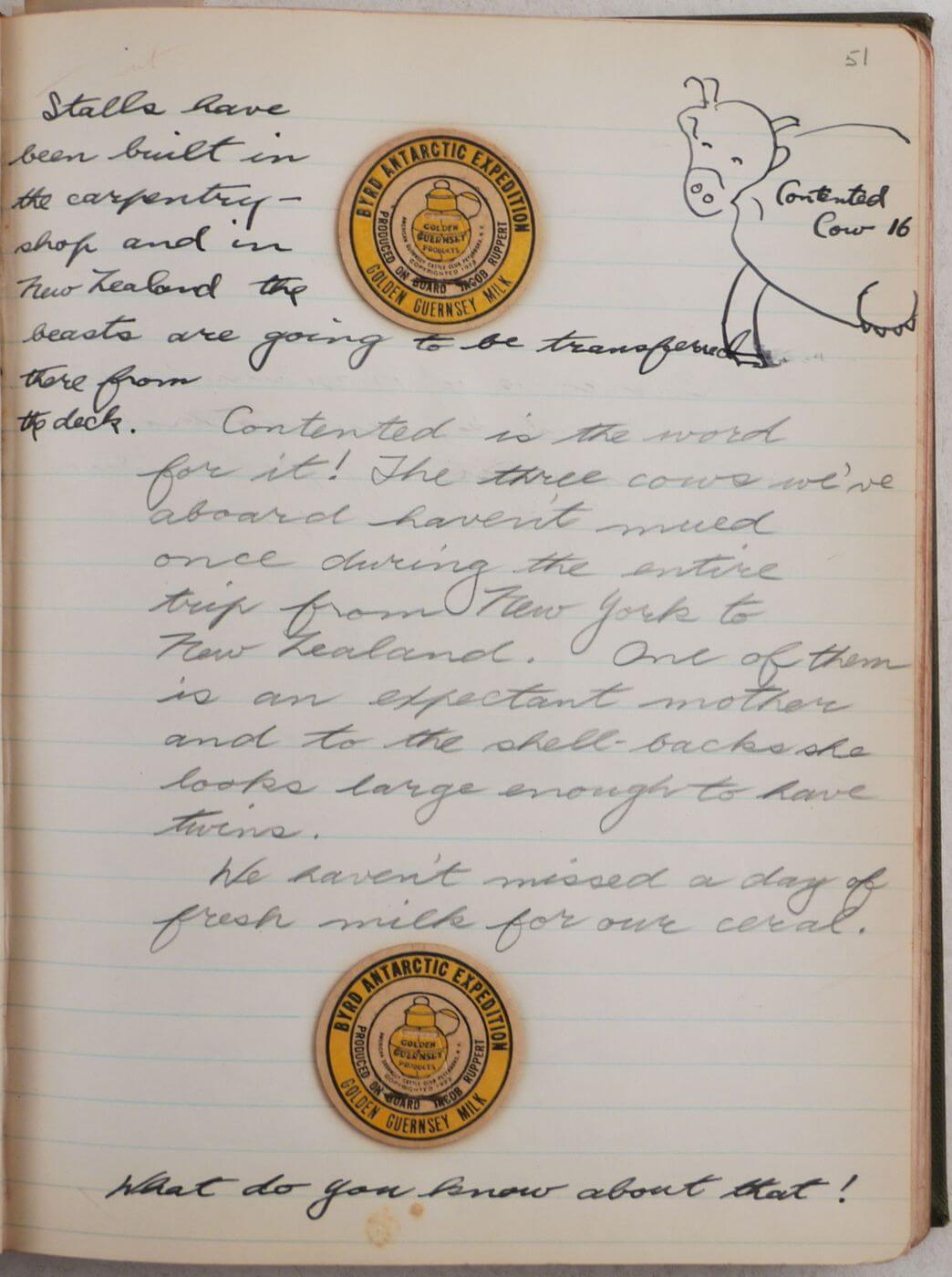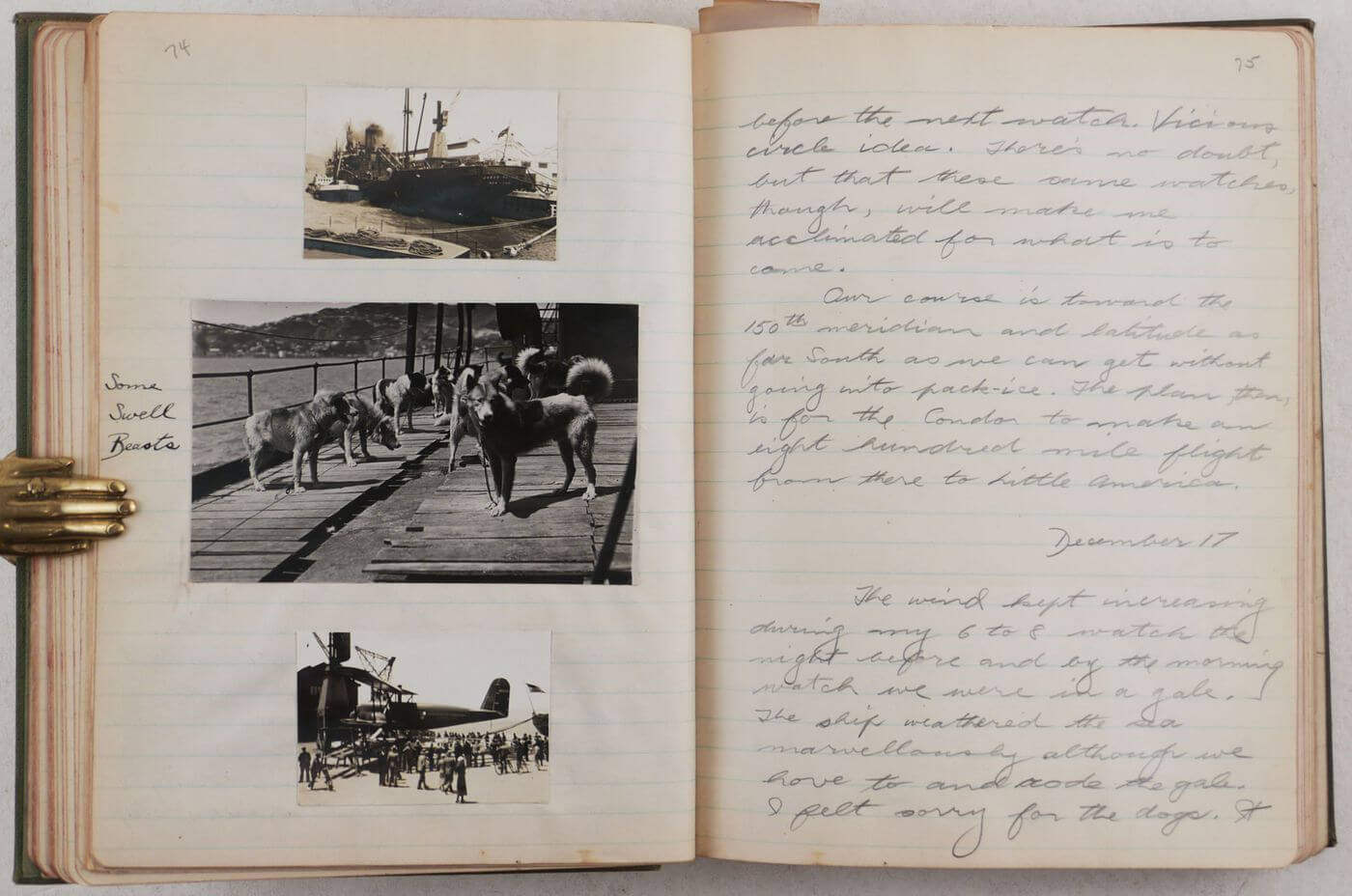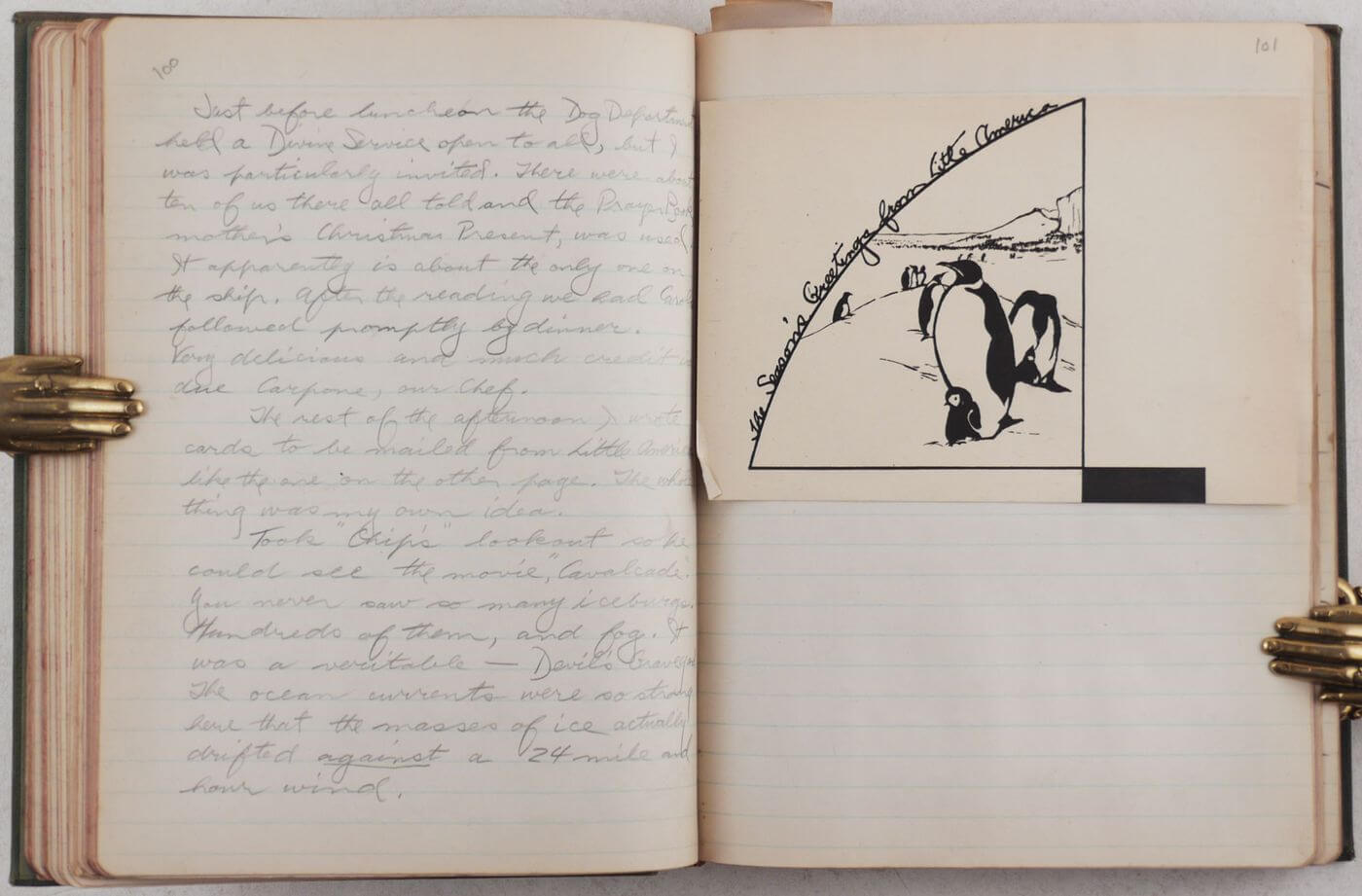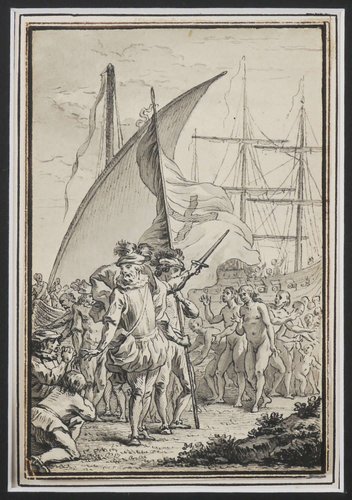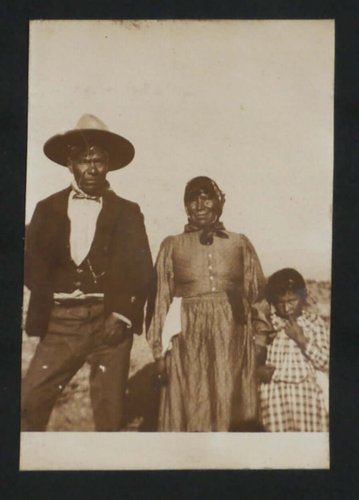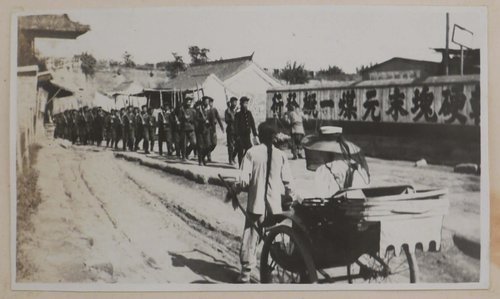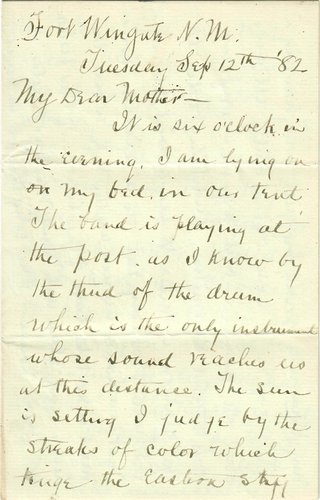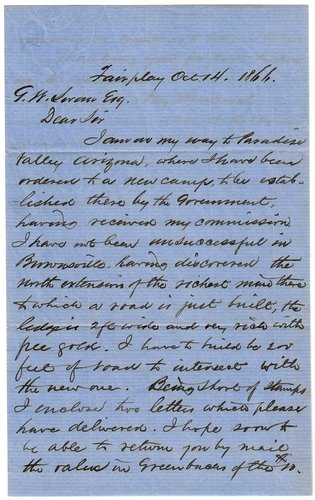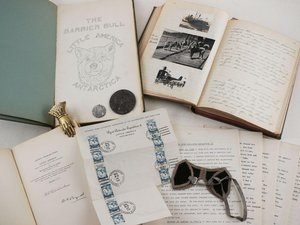
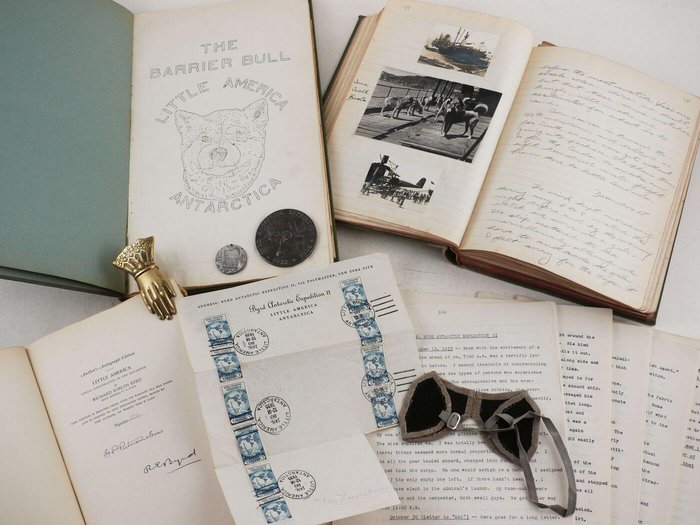
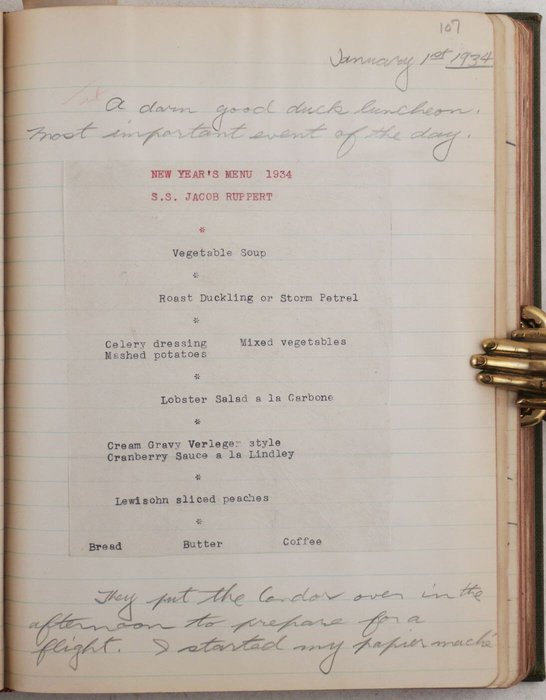
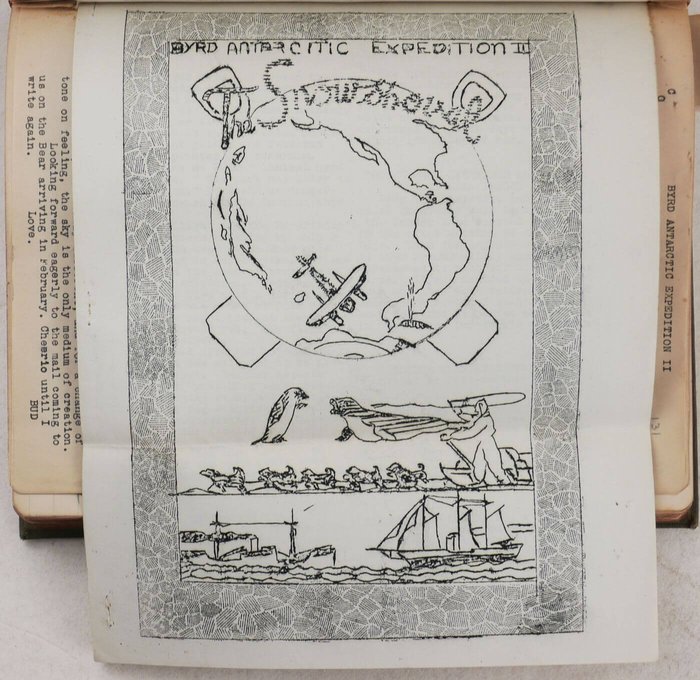
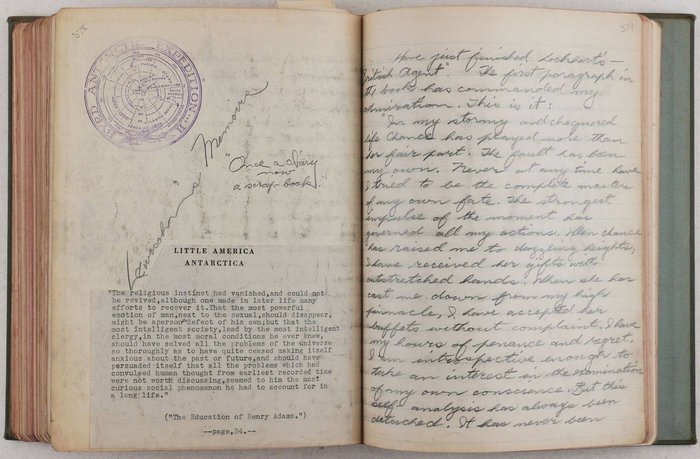
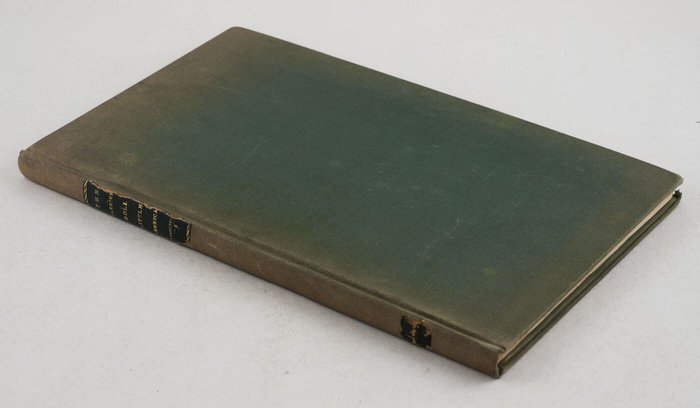
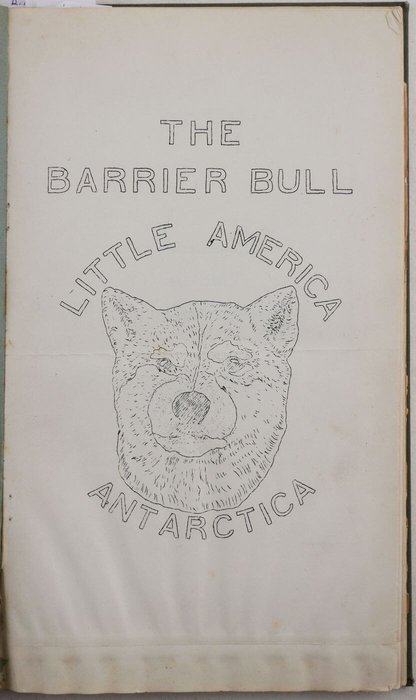
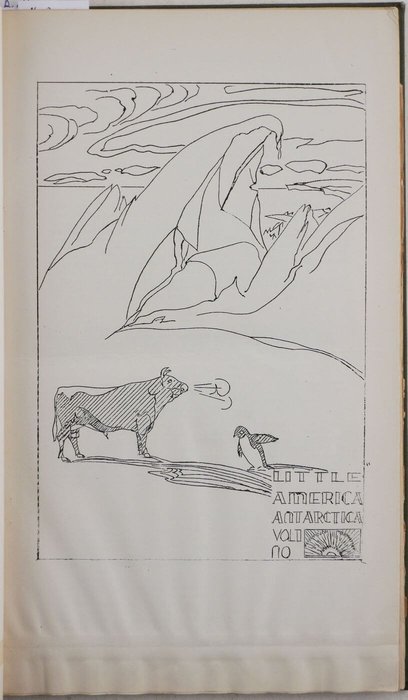
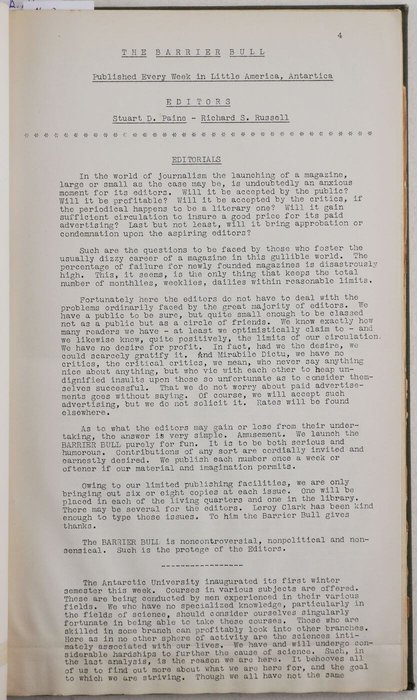
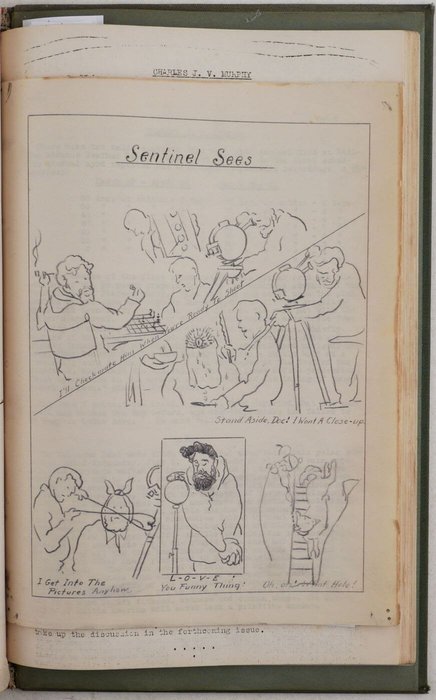
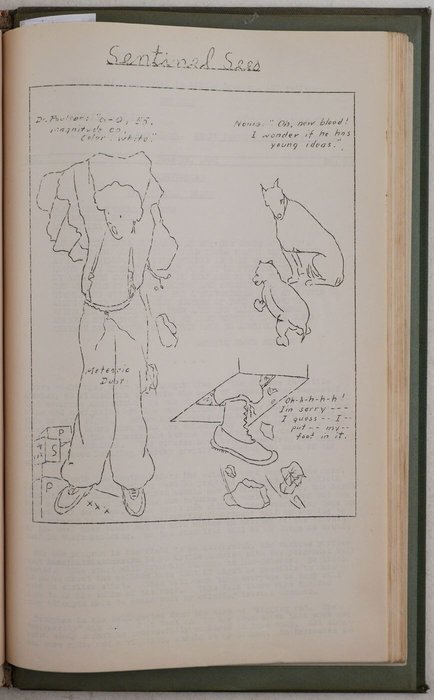
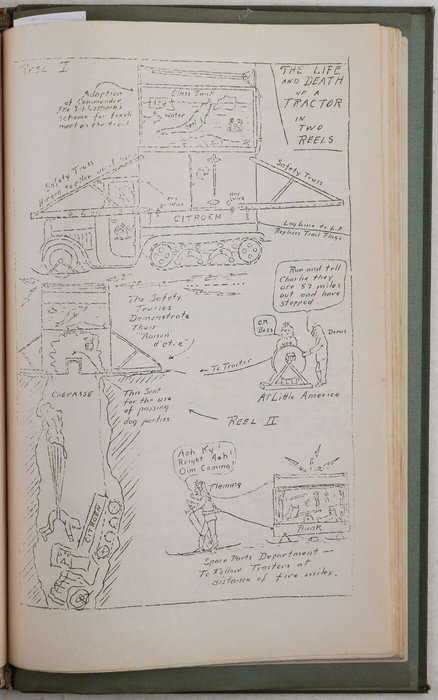
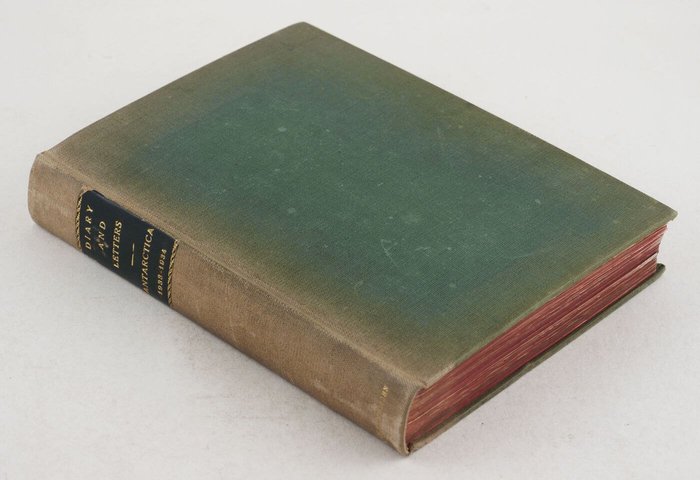
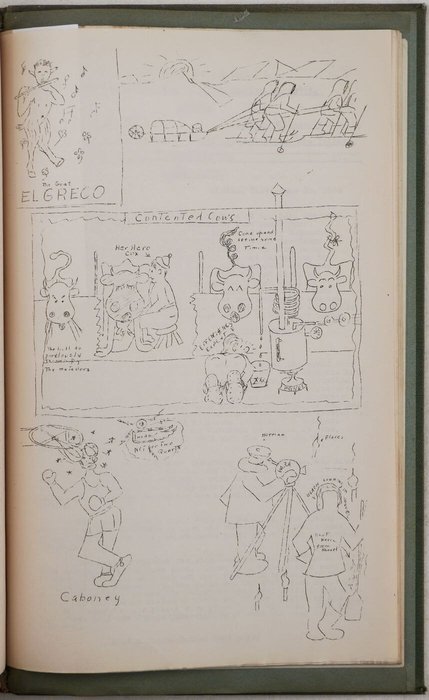
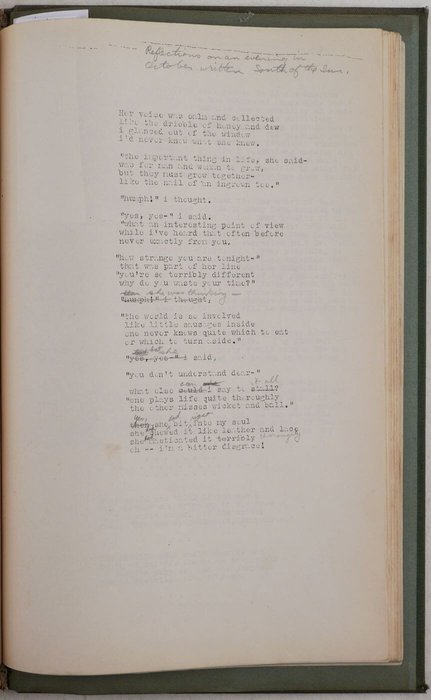
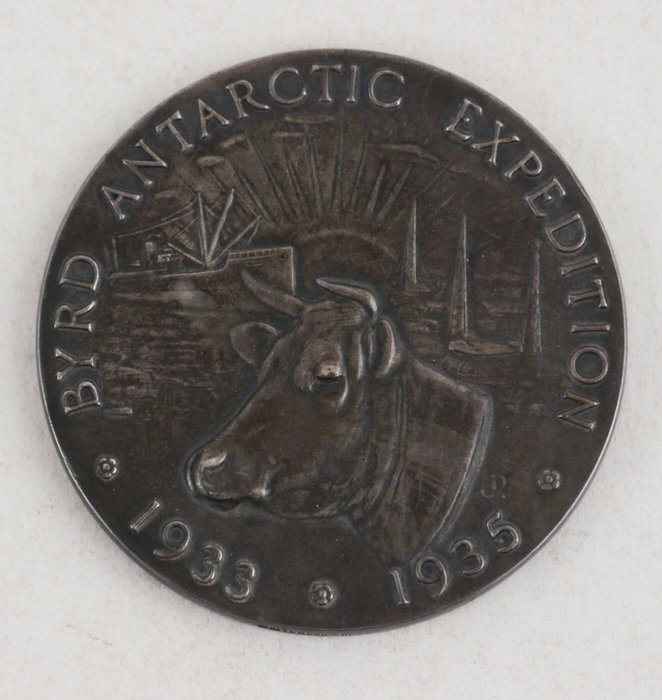
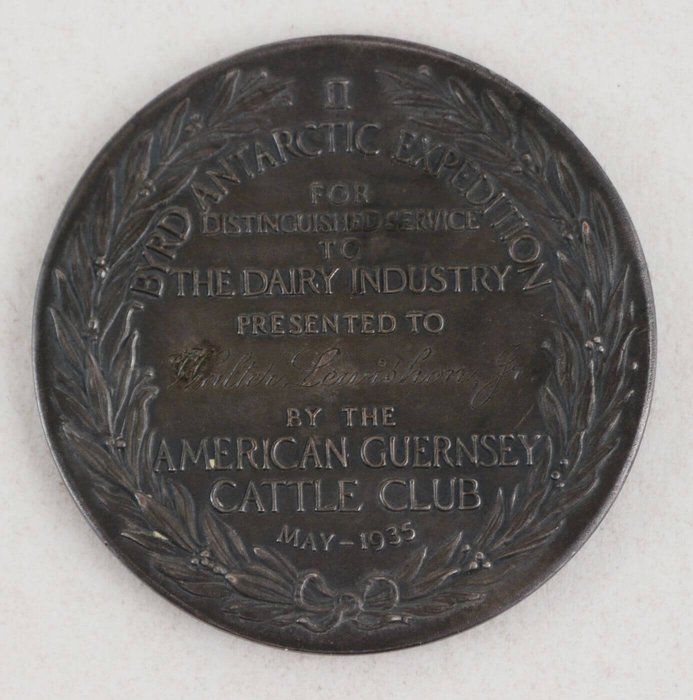
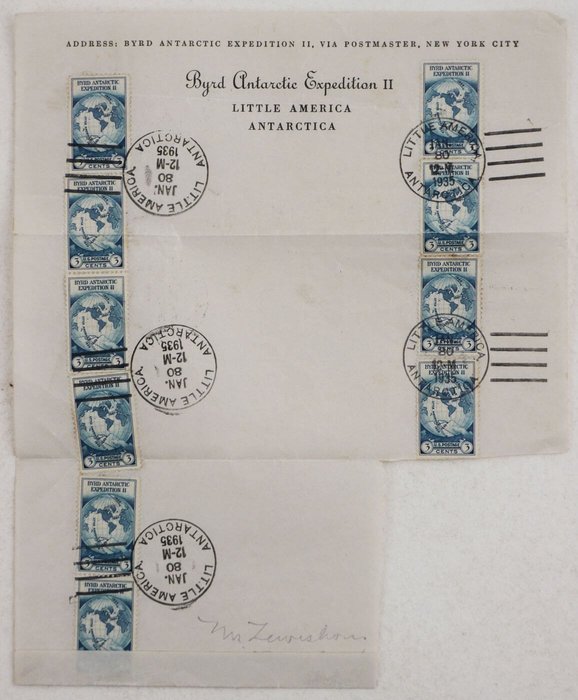
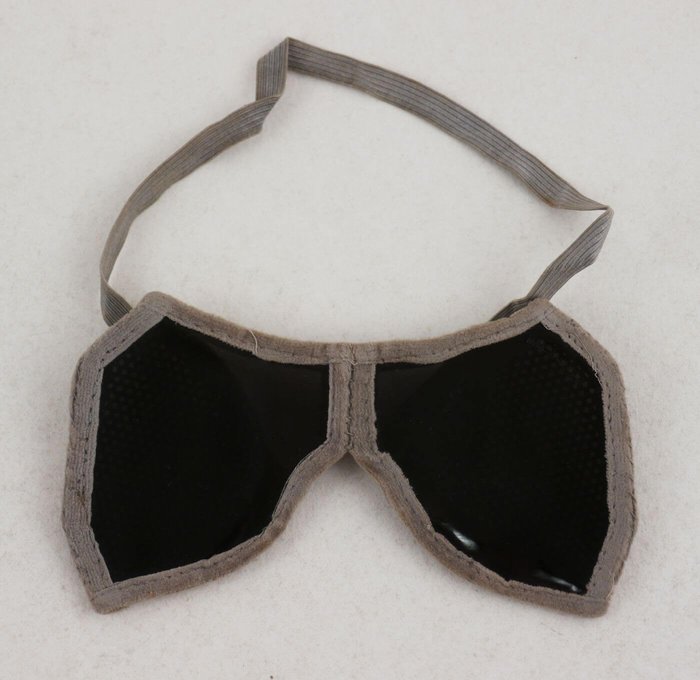
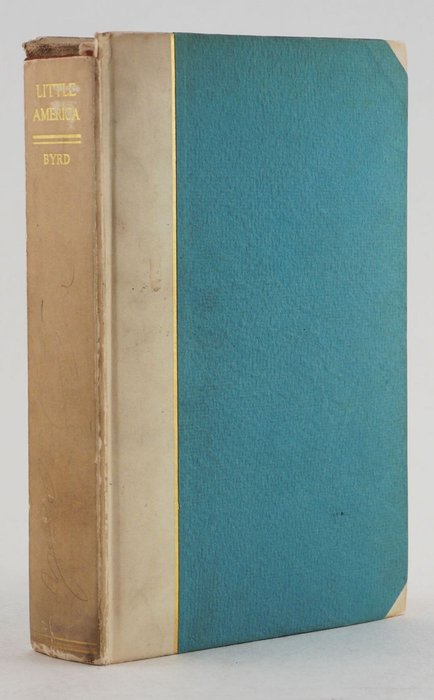
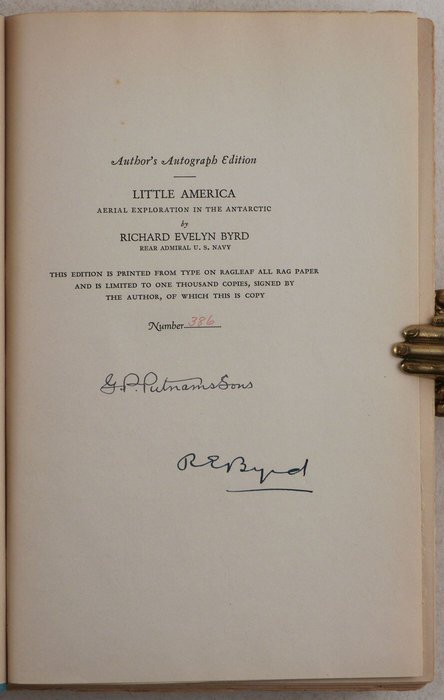
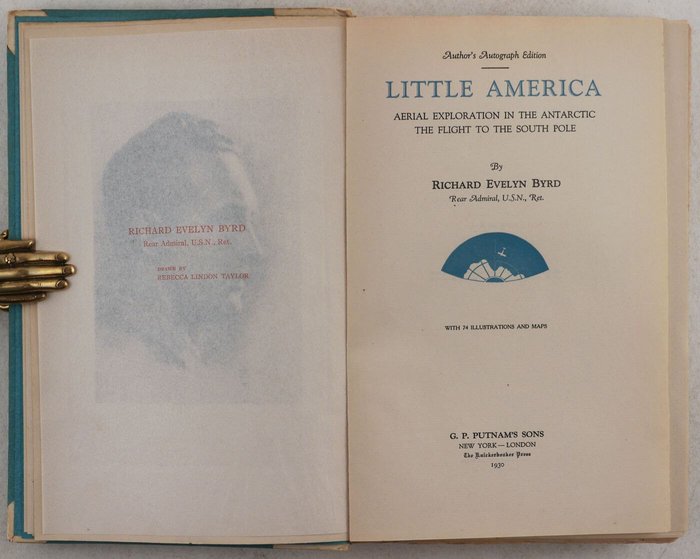
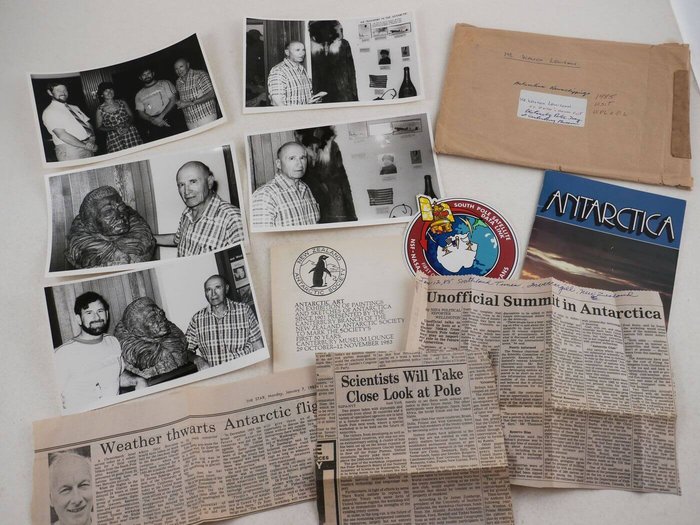
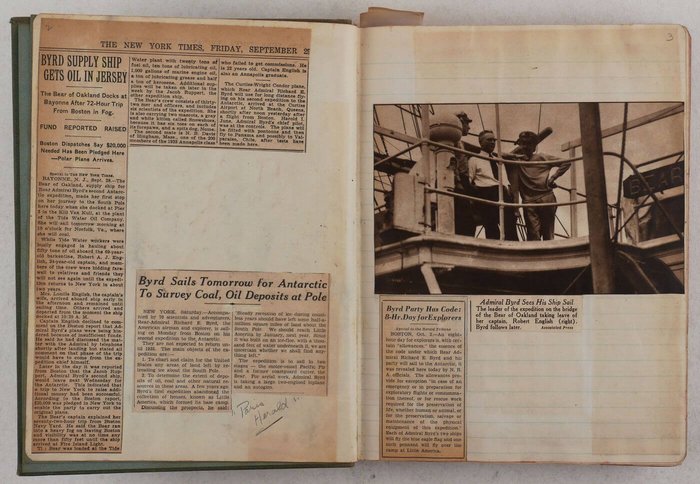
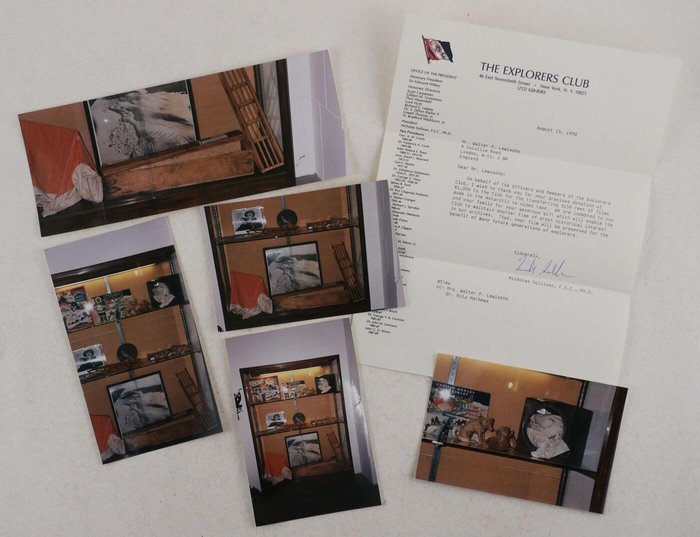
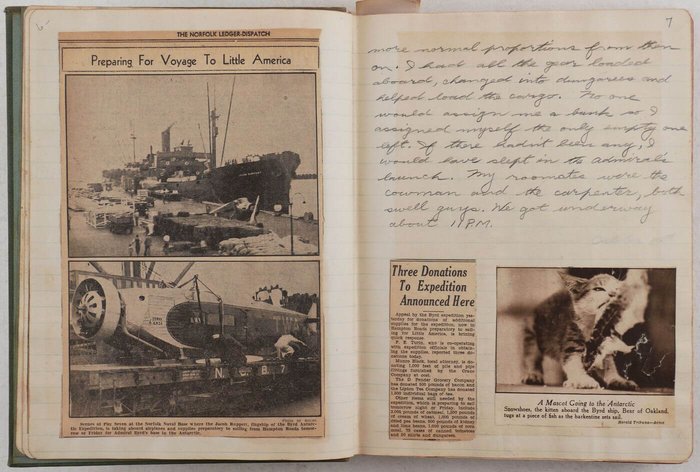
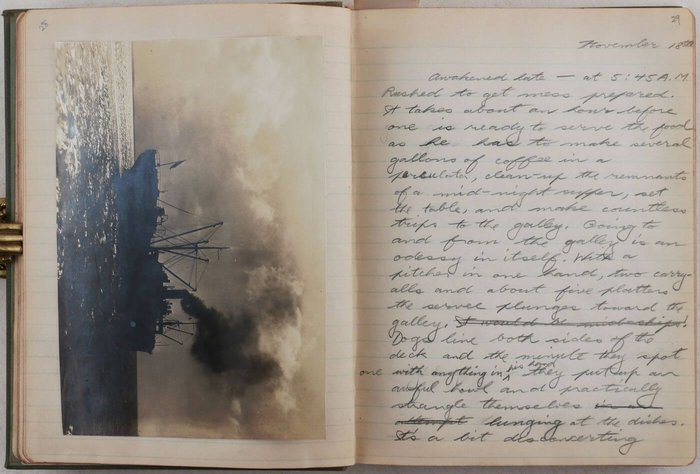
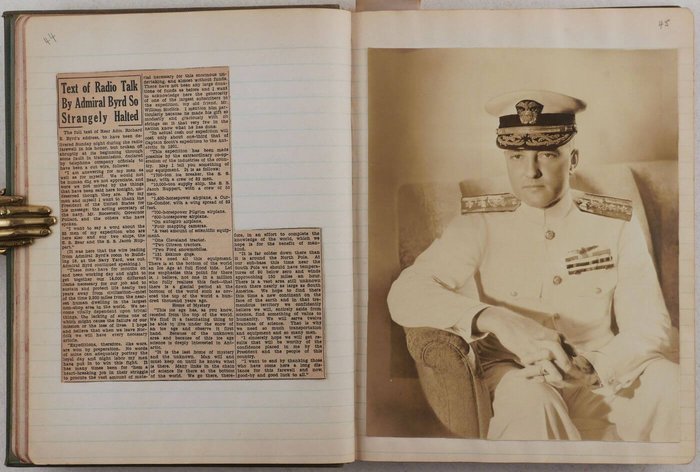
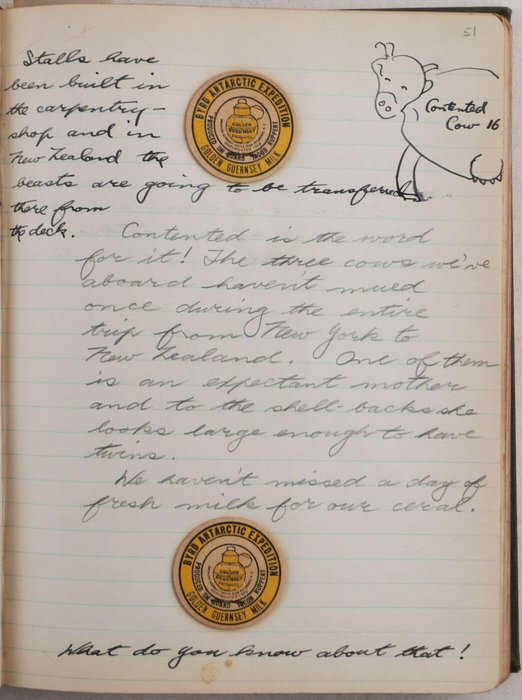
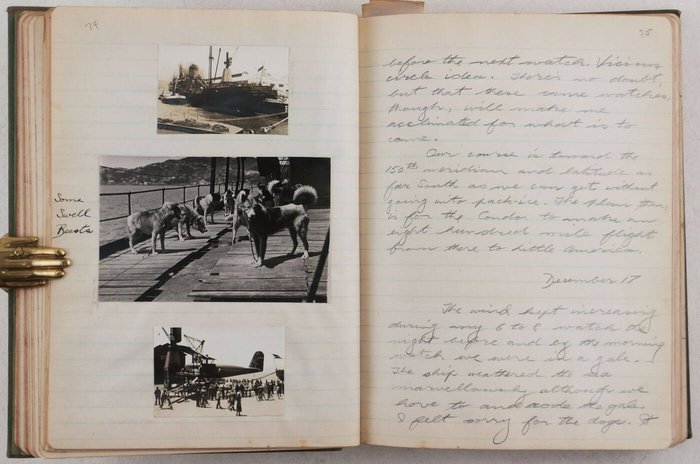
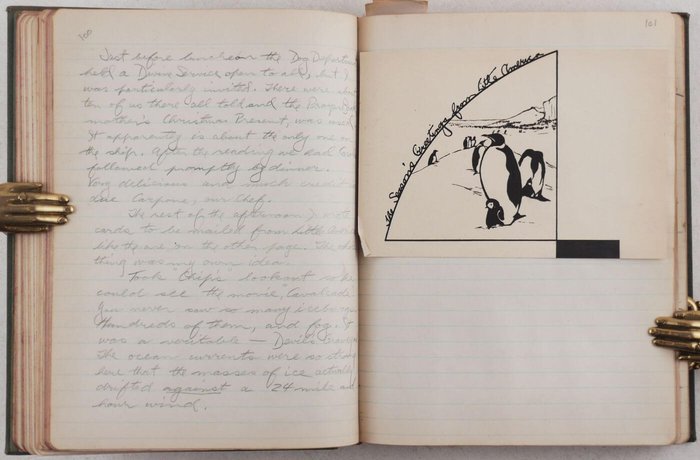
#MB14
Ca. 1933-1935
A historically significant collection of unique original materials, created and collected by a member of Admiral Richard Byrd’s Second Antarctic Expedition (1933-1935) and providing a personal, sometimes emotional account of people and events.
“Party of 56 men wintered at ‘Little America II,’ Bay of Whales, Ross Ice Shelf; the most elaborate expedition base established in the Antarctic to this time; 10 new buildings added to the 1928-30 base; eastern margin of the Ross Ice Shelf roughly charted during dog sledge journeys to Ford Ranges, Rockefeller Plateau and the eastern part of Queen Maud Mountains; geological party ascended Robert Scott Glacier to Polar Plateau; proved continental character of Marie Byrd Land and that, almost certainly, no direct sea connection existed between the Ross Sea and Weddell Sea; flights showed that the newly discovered Rockefeller Plateau probably extended from Ford Ranges to Queen Maud Mountains, but a small gap between 83°S and Horlick Mountains remained unexplored; surveys made in Queen Maud Mountains, Alexandra Mountains and Rockefeller Mountains; named and roughtly located trend of Ruppert Coast; extensive scientific program included seismic sounding of the Ross Ice Shelf and Rockefeller Plateau to determine position of the coast; advance weather station ‘Bolling Base,’ 170 km south of ‘Little America,’ occupied from 28 May to 14 October 1934, by Byrd alone until rescued (earliest inland wintering). <…> [Food supplies included 3 cows (one calved) for milk production. Post Office established with special United States postage stamps and ‘Little America’ cancellations; Byrd was appointed Post-Master. An autogyro aircraft was used, but it crashed. Regular radio programs were transmitted to the United States for broadcast, the earliest voice communications from Antarctica]” (Headland, R.K. A Chronology of Antarctic Exploration: A synopsis of events and activities from the earliest times until the International Polar Years, 2007-09; London: Quaritch, 2009; No. 2160).
Byrd’s Second Antarctic Expedition “discovered there was no straight connecting the Weddell and Ross Seas, as had been conjectured, confirming Antarctica was one continent. The ice cap’s depth was measured, and more life was discovered on the continent than previously thought. They returned with a mass of meteorological data and discovered many new mountains, a vast new plateau and more meteorites. There were a number of firsts: first seismic observations, first long-distance automotive transportation, first human voice broadcast from the continent [February 1, 1934], first cosmic ray observation and the first rotorcraft – an autogyro – on the continent” (Conrad, L.J. Bibliography of Antarctic Exploration: Expedition Accounts from 1768 to 1960. Washington, 1999, p. 290).
Three Guernsey cows, one of which gave birth to a bull calf, became the first working dairy in the Antarctic. Ostensibly brought to provide fresh milk for the members, they maximized the expedition’s publicity and possibly acted as “colonial agents,” supporting the American claim for that sector of Antarctica, as “Little America” looked more like a settlement with a running post office, a radio station and farming livestock (See more: Leane, E. Nielsen, H.E. American Cows in Antarctica: Richard Byrd’s polar dairy as symbolic settler colonialism// Journal of Colonialism and Colonial History. John Hopkins University Press. Vol. 18, No. 2, Summer 2017).
The expedition issued the first American publication on the Antarctic Continent – eight issues of the mimeographed magazine titled “Barrier Bull” (Little America, Vol. I, Nos. 1-8, May 19 – July 7, 1934). The publication is not in the bibliographies by M.H. Rosove, S.A. Spence, and L.J. Conrad. Very rare, with only one copy found in Worldcat (the University of New Hampshire, Dimond Library Special Collections). The second known copy is in the possession of the family of one of the “Barrier Bull’s” editors, Stuart D. Paine (Preface/ Footsteps on the Ice: The Antarctic Diaries of Stuart D. Paine, Second Byrd Expedition. Ed. by M. L. Paine. Columbia and London: University of Missouri Press, 2007, pp. xxv-xxvii).
"The Barrier Bull was the only internal magazine compiled within Little America during the expedition. <…> As a pleasurable distraction during the winter night, Paine initiated the Barrier Bull. Editors Paine and Dick Russell, in addition to publishing their own pieces, solicited articles from the other fifty-three members of the ice party at Little America. The column by Charlie Murphy both supplied information regarding his communications with Admiral Byrd, who was alone at Advance Base, and made wry comments about the internal dynamics of Little America. More straightforward were the editorials about the summer field plans, the conditions, problems, and possible solutions within the men's society, and a strong commentary on leadership and the issue of whether to rescue Admiral Byrd before spring. In addition, selected articles written by Paine vividly describe the world of the radiomen, the dog drivers, the solution to dental problems, and the story of an ill-conceived winter field trip across the Bay of Whales. (Paine Antarctic Collection)" (Appendix 4/ Footsteps on the Ice: The Antarctic Diaries of Stuart D. Paine, Second Byrd Expedition. Ed. by M. L. Paine. Columbia and London: University of Missouri Press, 2007, pp. 295-296).
* * *
Twenty-three-year-old Walter P. Lewisohn was a member of the shore party, hired as an archaeologist, but in fact, carried out several jobs, including working in the mess, the radio station, the dairy and taking photographs. A member of an affluent New York Jewish family of metal traders (his grandfather founded the Lewisohn Brothers in 1866), Walter studied at the University of Wisconsin (1831-32) and prior to joining Admiral Byrd, took part in Donald MacMillan’s expedition to Baffin Island, two archaeological digs in the American Southwest and George Miller Dyott’s expedition to Ecuador. In 1933, he joined the Explorers Club in New York. Later, he studied at the Yale Drama School, travelled around the world and filmed. A Nunatak in the Marie Byrd Land was named after him by the United States Antarctic Service (1939-41). Some of his materials are held in the archives of the Explorers Club and the Special Collections of the J.D. Williams Library (the University of Mississippi; see more).
The collection includes:
I. LEWISOHN, Walter Pickett. [Original, Extensively Illustrated Diary Kept during Byrd’s Second Antarctic Expedition, Friday, October 13, 1933 – December 31, 1934].
Quarto diary (ca. 26,5x20 cm or 10 ½ x 7 ¾ in). 450 pp., numbered in pencil in the upper corners (7 leaves at the rear are blank). Manuscript text in pencil on lined paper. The text is illustrated with ten mounted original gelatin silver photographs from ca. 15,5x22 cm (6 x 8 ¾ in) to ca. 5x7,5 cm (2x3 in), several pieces of ephemera printed for the expedition or in Antarctica, numerous newspaper clippings, a dried flower specimen, telegrams and letters received by Lewisohn during the expedition, original pencil drawings in text, &c. Period olive green full cloth binding; spine with a sheep label with gilt-lettered title and the author’s gilt-lettered name on the bottom. Spine slightly faded, but overall a very good diary.
The text of the diary combines daily entries with excerpts from the books Lewisohn read during the expedition, as well as poems or reflections he compiled. Among the other events and proceedings on board the S.S. “Jacob Rupert” and in Little America, Lewisohn describes his visit to the Easter Island (pp. 14-26), everyday jobs, the expedition artist making his portrait in a “parka and muskrat hat” (p. 138), building of the mess hall and the library, conflicts and dissatisfaction with other expedition members, interactions with Byrd, a fire and appendicitis operation performed on his bunk (p. 163), mistreatment of dogs (p. 167), Byrd leaving to the Advanced Base weather station without saying good-bye to anyone (p. 169), the departure of sun until August (p. 186), “Little America mail scandal” (pp. 188-189), making a snow sculpture for Mother’s Day (pp. 198, 201), the start of the “Winter School of the Antarctic” (p. 205), shooting movies “of blubbering process” (p. 219), suffering from malaria (p. 237) and a stye (p. 265), gaining 20 lbs. (p. 269), radio communications with Byrd (p. 270), the effects of alcohol prohibition on the party’s morale (pp. 271, 273), the test trip of the “Eastern party” (pp. 277, 279), taking “night-flare photography” (p. 281), having a “grand and glorious bath” (p. 285), “the Admiral all but demanded the tractors out to relieve him at the Advance Base” on July 7 (p. 291), the unsuccessful rescue attempt on July 20 (p. 307, 309, 311), the second rescue attempt on August 5 (pp. 323, 325), Admiral’s rescue on August 10 (p. 329), the “useless exploiting of volunteer labor” (p. 333), the return of Admiral Byrd and the Eastern Party to Little America on October 12 (p. 375), &c. Pp. 375-436 are mostly occupied with excerpts from the books Lewisohn read in Antarctica.
The diary contains two extremely rare issues of “The Snowshovel. Byrd Antarctic Expedition II” – a mimeographed newsletter issued on board the expedition ship “Jacob Ruppert” on January 6 and January 13, 1934. Worldcat finds only one paper copy of the periodical – in the Museum of Auckland, New Zealand (also Issues No. 1 and 2; see more). Another copy is in the Byrd Polar and Climate Research Center of the Ohio State University (see more). Most likely, only two issues were published. M.L. Paine characterized “The Snowshovel” and the “Stormy Petrel” – “mutually rivalling newsletters” issued on board the “Jacob Ruppert” on its way to Antarctica as “extremely short-lived” (Footsteps on the Ice: The Antarctic Diaries of Stuart D. Paine, Second Byrd Expedition, p. 295). Our issues have 4 and 3 leaves, respectively; each is supplemented with an illustrated title page (the Earth supported by two snow shovels, with a dog sled, penguins and expedition ships underneath). Lewisohn is listed as a “free lance” in the list of contributors to both issues.
The original photos include a portrait of Richard Byrd, views of the expedition ship “Jacob Ruppert” (from the distance, the ship’s deck en route with the cows and dogs), one of the expedition planes, Lewisohn and his companion on Easter Island, and a portrait of the expedition husky dog.
The ephemera mounted in the diary: two tokens of “Golden Guernsey Milk, produced on board Jacob Ruppert, Byrd Antarctic Expedition;” a telegram and a letter from his relatives; a lithographed greetings card (an Antarctic scene with penguins and text “The Season’s Greetings from Little America”); typewritten “New Year’s Menu, 1934, S.S. Jacob Ruppert;” and several leaves with typewritten quotes from various books, including about a dozen with printed letterheads of “Little America, Antarctica.”
The diary also contains a typewritten “Memo for Lewisohn” from Richard Byrd, dated February 27, 1934 and asking him to “lending me for a while the following books…”; five typewritten copies of Byrd’s letters to “Mol” (possibly, a cousin), dated October 30, December 1 and 9, 1933, January 23 and February 25, 1934; a dried flower specimen, &c.
II. [A typescript of Lewisohn’s diary, titled:] Richard E. Byrd Antarctic Expedition II.
Quarto (ca. 28x21,5 cm or 11 x 8 ½ in). 120 loose leaves of wove paper (numbered I-1 – I-67; J-1 – J-53) with typewritten text on rectos. The typescript was possibly intended for publication and has several omissions of the original manuscript text (mostly with negative comments about Byrd and other expedition members).
III. The Barrier Bull. Little America, Antarctica/ Ed. by Stuart D. Paine and Richard S. Russell. Vol. I, Nos. 1-8, May 19 – July 7, 1934 [all published].
Folio (ca. 36x22 cm or 14 ¼ x 8 ½ in). Eight issues. 108 leaves (leaves in issues No. 1, 2 and 3 are numbered in the right upper corners). Mimeographed typewritten text on rectos. With two illustrated title pages, four illustrations on separate leaves and a sketch map in text. Lewisohn’s pencil manuscript notes and corrections on the last pages of Nos. 5 and 8. Period olive green full cloth binding; spine with two sheep labels with gilt-lettered title and the author’s name. Binding slightly faded, labels on the spine with minor chipping on extremities, but overall a very good copy.
Very Rare Antarctic imprint with only one copy found in Worldcat (the University of New Hampshire, Dimond Library Special Collections).
“Typewritten and mimeographed weekly newsletter written for people stationed in Little America in 1934” (Worldcat). Chronologically, it falls on the period of the 1934 polar night, the expedition endured in the Antarctic. Includes editorials, columns by Charles J.V. Murphy (journalist, expedition member, Byrd’s friend and author of his travel accounts), humorous sketches about life in Little America, news, reports by the scientific department, interviews with and poems by the expedition members, &c. Murphy’s column in No. 8 informs about the first failure of communication with Richard Byrd on July 5 (which led to three rescue operations in July in August 1934). A poem in No. 5 has Lewisohn’s manuscript notes and corrections and was evidently written by him. A poem in No. 8, titled “Custer’s Last Stand” was authored by him (typewritten name underneath). A pencil note on the last leaf was apparently made by Lewisohn in Antarctica: “The ghost of Admiral Peary is behind schedule. I am filled with [rum?] and fatigue. I love the primitive [sic!] of it all. I’m just a male virgin a long way from home. You can discuss ladies from 67 different angles and still come to no logical conclusion.”
A list of illustrations: a) [General title page, illustrated with the head of a husky dog:] The Barrier Bull. Little America, Antarctica; b) [Title page to vol. 1, illustrated with a scene with Antarctic mountains, a Guernsey bull and a penguin:] Little America, Antarctica, Vol. 1. No. _; c) [Scenes from the life at Little America:] Sentinel Sees; d) [Scenes from the life at Little America, with two dogs:] Sentinel Sees; d) The life and death of a tractor in two reels; e) Sketch chart of the Bay of Whales showing route of man-hauling party; f) [Scenes from the life at Little America:] The Great El Greco, Contented Cows, Caboney, &c.
IV. Lewisohn’s original snow glasses from the expedition.
Ca. 12,5x7,5 cm (5x3 in). Black flexible plastic lenses, fabric trim, elastic band.
V. Original medal presented to Lewisohn by the American Guernsey Cattle Club in May 1935.
White metal, ca. 6x6 cm (2 ½ x 2 ½ in). Obverse: a relief showing the head of a Guernsey cow, an expedition ship, Little America station, a plane and a rising sun. Text: “Byrd Antarctic Expedition. 1933-1935.” Artist’s initial “P.” in the right lower corner. Reverse: a garland of laurel leaves surrounding the text: “II Byrd Antarctic Expedition. For distinguished service to the dairy industry. Presented to Walter Lewishon [sic!] Jr. by the American Guernsey Cattle Club. May 1935.”
VI. Original medal presented by the U.S. Congress to Kennett Longley Rawson (1911-1992), a navigator of Byrd’s Second Antarctic Expedition. Ca. 1935.
White metal, ca. 3x3 cm (1 1/8 x 1 1/8 in). Obverse: A relief figure of an Antarctic explorer dressed in parka and accompanied by a sled dog. Text: “Byrd Antarctic Expedition, 1933-1935.” Artist’s initials “H.W.” in the lower right corner. Reverse: a plaque with the text in the centre: “Presented to the officers and men of the Second Antarctic Expedition to express the very high admiration in which the Congress and the American people hold their heroic and undaunted accomplishments for science unequaled in the history of polar exploration.” The plaque is surrounded with the relief images of a plane, a polar station, a sail ship and a pack of sled dogs. Edge: inscription “K.L. Rawson.”
Kennett L. Rawson participated in several Arctic expeditions, led by Donald MacMillan in 1925-1929. During Richard Byrd’s Second Antarctic Expedition, Rawson served as a navigator and took part in the tractor and plane trips around the Little America base, mapping previously unexplored land. He left an account of his first trip to the Arctic (A Boy’s-Eye View of the Arctic. New York, 1926) and later in life made a career in the publishing business.
VII. A paper sheet with the printed letterhead of Byrd Antarctic Expedition II and ten original expedition stamps, cancelled by the post office in Little America in January 1935.
Watermarked wove paper sheet ca. 26x21,5 cm (10 ¼ x 8 ½ in). Printed letterhead “Address: Byrd Antarctic Expedition II, Little America, Antarctica, via Postmaster, New York City”. With ten mounted 3-cent blue postal stamps, all cancelled with round ink stamps reading “Little America, Antarctica, Jan. 30 12-M 1935.” The design of the distinctive blue postal stamps showing the Earth and the routes of Byrd’s flights and expeditions was inspired by Franklin D. Roosevelt.
VIII. [Official account of Byrd’s First Antarctic Expedition (1928-1930), signed by the author]:
BYRD, Richard Evelyn. Little America: Aerial Exploration in the Antarctic. The Flight to the South Pole. Author’s Autograph Edition.
New York-London: G.P. Putnam’s Sons, 1930. xvi, 436 pp.; ill., maps. No. 386 of a limited edition of 1000 copies, signed by the author and the publisher on the half-title. Lacks two maps at the rear, binding rubbed on extremities, the head of the spine chipped, no dust jacket, but overall a good copy.
IX. A group of newspaper clippings, photographs and ephemera, related to and collected by Lewisohn during his visit to Christchurch in January 1985 in the course of a series of international workshops on the future of Antarctica.
X. An original autograph letter signed to Lewisohn by Nicholas Sullivan, the president of the Explorers Club in New York in August 1990, regarding the former’s donation to the club. With five original photographs (ca. 1990s, four with pen captions on verso) of a display case in the Explorers Club with the items which Lewisohn brought from Antarctica.

